Yaesu Musen 20523X50 VHF DIGITAL/ANALOGUE TRANSCEIVER User Manual OM
Yaesu Musen Co., Ltd. VHF DIGITAL/ANALOGUE TRANSCEIVER OM
Contents
- 1. User Manual - 1
- 2. User Manual 2
- 3. User Manual - 2
User Manual 2
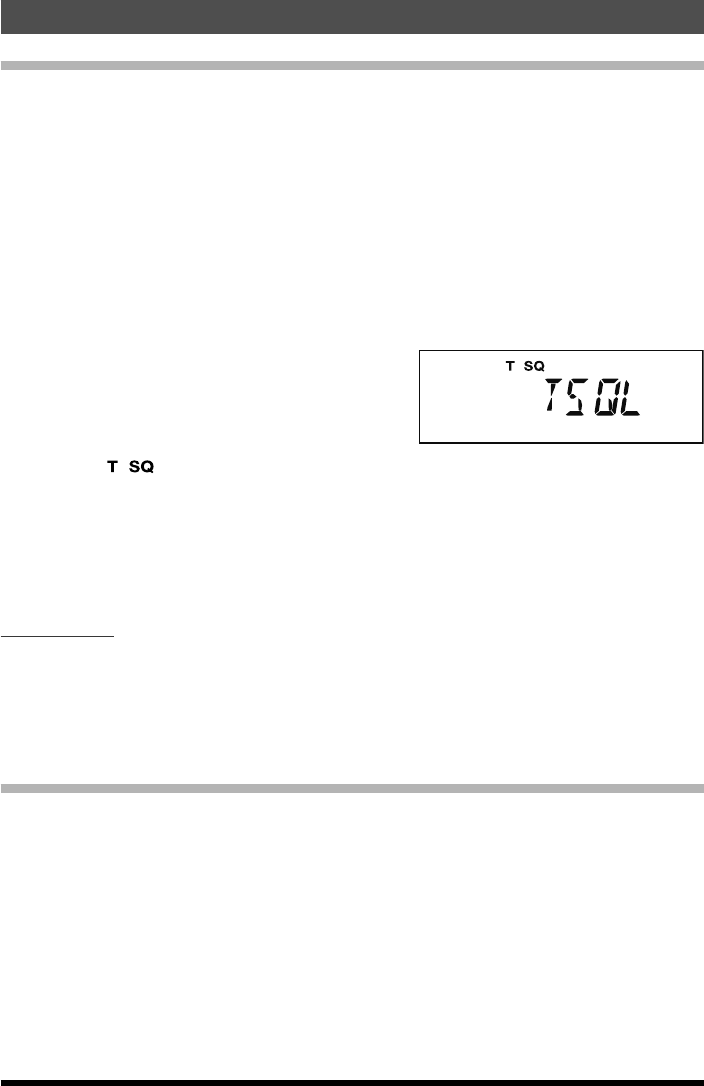
21
Advanced Operation
FTM-3200DR Operating Manual
CTCSS Operation
This radio is equipped with the CTCSS (Continuous Tone-coded Squelch System which
allows audio to be heard only when receiving signals containing the same frequency tone
as the tone that has been set in the tone squelch menu. By matching the tone frequency
with the partner station in advance, a quiet standby monitoring is possible.
Caution: CTCSS does not function in digital mode. To transmit a signal using a CTCSS
code, use the [D/A(GM)] key to switch the communication mode to AMS (Auto
Mode Select function) or analog (FM) mode.
1. Press and hold in the [MHz(SETUP)] key for over 1 second.
The Setup menu appears.
2. Rotate the DIAL knob to select “SQL TYPE 42”, then press the [MHz(SETUP)] key.
3. Rotate the DIAL knob to select “TSQL”, then
press and hold in the [MHz(SETUP)] key for
over 1 second.
Displays “ ” on the screen. The squelch opens only when receiving tone signals
of the set frequency.
Note: From the Setup Menu, you can change the CTCSS setting.
TONE FRQ 45 à The tone frequency can be selected from 50 frequencies.
BELL 6 à A bell tone (beep) may be set to sound when signals containing
a corresponding CTCSS tone are received.
Tone Search
In operating situations where you don’t know the CTCSS tone being used by another
station or stations, you can command the radio to listen to the incoming signal and scan
in search of the tone being used.
Note: For details, refer to the Advanced Manual (download from the Yaesu website).
DCS Operation
This radio is equipped with a DCS (Digital Coded Squelch) function that allows audio to
be heard only when signals containing the corresponding DCS code are received. By
matching the DCS code with the partner stations beforehand, a quiet receive standby is
possible.
Caution: DCS does not function in digital mode. To transmit a signal with a DCS code,
use the [D/A(GM)] key to switch the communication mode to AMS (Auto Mode
Select function) or analog (FM) mode.
1. Press and hold in the [MHz(SETUP)] key for over 1 second.
The Setup menu appears.
2. Rotate the DIAL knob to select “SQL TYPE 42”, then press the [MHz(SETUP)] key.
Application for FCC / IC
FCC ID: K6620523X50 / IC: 511B-20523X50
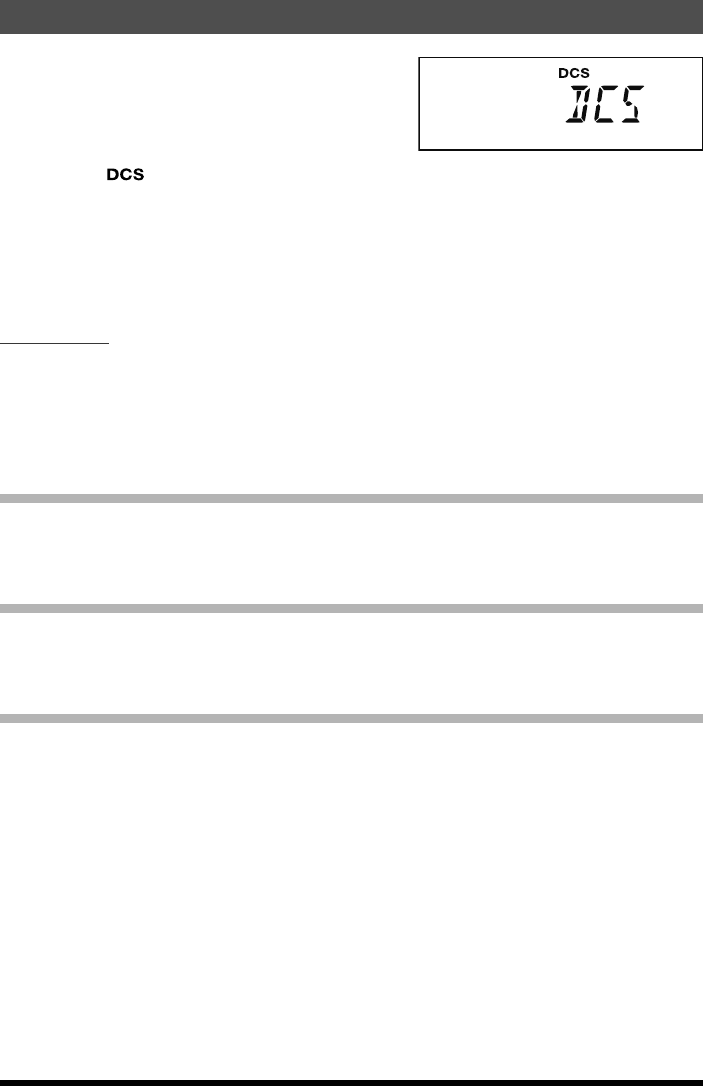
22
Advanced Operation
FTM-3200DR Operating Manual
3. Rotate the DIAL knob to select “DCS”, then
press and hold in the [MHz(SETUP)] key for
over 1 second.
Displays “ ” on the screen. The squelch opens only when receiving a signal con-
taining the corresponding DCS code.
Note: From the Setup Menu, you can change the DCS setting.
DCS CODE 9 à The DCS code can be selected from 104 codes.
BELL 6 à A bell tone (beep) may be set to sound when signals containing
a corresponding DCS code are received.
DCS Search
In operating situations where you don’t know the DCS code being used by another station
or stations, you can command the radio to listen to the incoming signal and scan in search
of the code being used.
Note: For details, refer to the Advanced Manual (download from the Yaesu website).
EPCS (Enhanced Paging & Code Squelch) Operation
Use the pager code consisting of 2 CTCSS tones to exchange communications with
specified stations.
Note: For details, refer to the Advanced Manual (download from the Yaesu website).
Split Tone Operation
The FTM-3200R can be operated in a “Split Tone” configuration, to enable operation on
repeaters using a mix of both CTCSS and DCS control via the Setup menu.
Note: For details, refer to the Advanced Manual (download from the Yaesu website).
DTMF Operation
DTMF tones (Dual Tone Multi Frequencies) are the tones you hear when dialing from a
telephone keypad. The FTM-3200DR transceiver can transmit the DTMF codes by using
the keys on the microphone or recalling registered numbers from memories.
The maximum of 16-digit DTMF codes can be registered in up to 10 memory channels.
It is convenient to register telephone patch numbers, and network linking sequences to
the DTMF memory channels.
Note: For details, refer to the Advanced Manual (download from the Yaesu website).
Application for FCC / IC
FCC ID: K6620523X50 / IC: 511B-20523X50
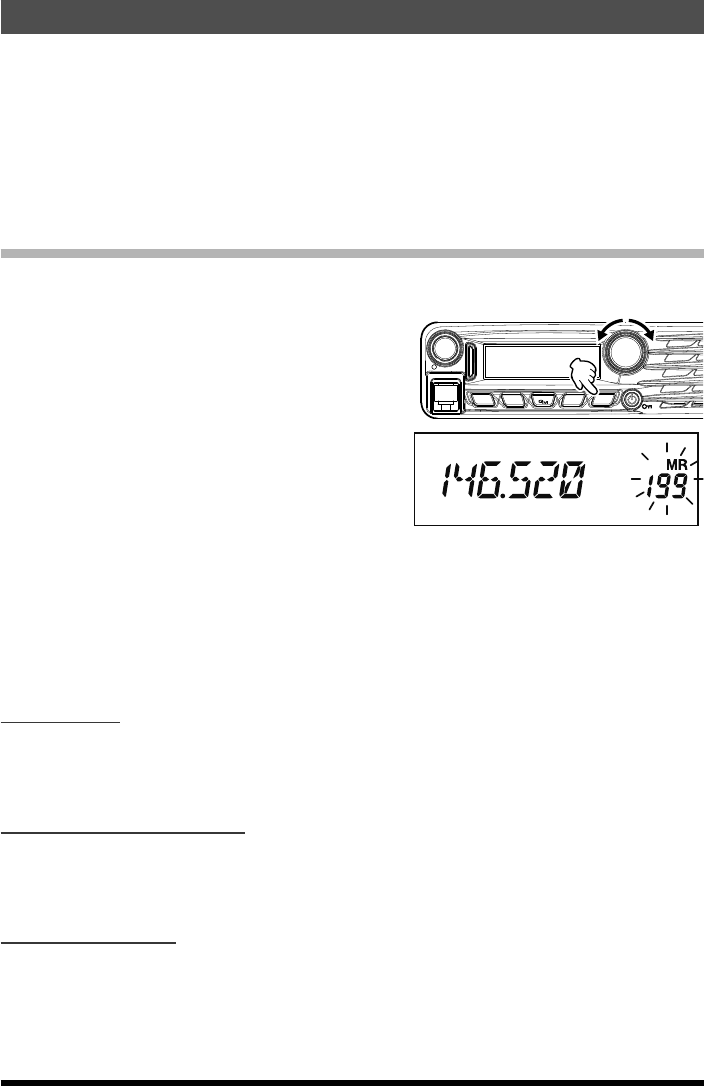
23FTM-3200DR Operating Manual
Memory Operation
The FTM-3200R provides a wide variety of memory system resources. These include:
r 199 “basic” memory channels, numbered “1” through “199”.
r A “Home” channel, providing storage and quick recall of one prime frequency.
r 10 sets of band-edge memories, also known as “Programmable Memory Scan”
channels, labeled “L0/U0” through “L9/U9”.
Each memory may be appended with an alpha-numeric label of up to 8 characters, for
quick channel recognition.
Memory Storage
1. In the VFO mode, select the desired frequency, repeater shift, CTCSS/DCS tone, and
TX power level.
2. Press and hold in the [V/M(MW)] key for 1
second.
A memory number will appear in the bottom
right corner of the display.
Note: If the channel number is blinking,
there currently is no data stored on
that channel; if the channel number is
not blinking, that channel is currently
“occupied” by other frequency data.
VOL
DIAL
SQL
TXPO DW MW
SETUP
REV D/A V/MMHz
3. Within five seconds of pressing the [V/M(MW)] key, use the DIAL knob to select the
desired memory into which you wish to store the frequency.
4. Press the [V/M(MW)] key again, this time momentarily, to store the displayed data into
the selected memory channel slot.
5. To store other frequencies, repeat steps 1 through 4, remembering to set the repeater
shift, CTCSS/DCS tone, and TX power level, as appropriate.
Split Memory
A separate transmit frequency may be registered to a memory channel to which a receive
frequency has already been registered.
Note: For details, refer to the Advanced Manual (download from the Yaesu website).
Naming a Memory Channel
You may wish to append an alpha-numeric “Tag” (label) to a memory or memories, to aid
in recollection of the channel’s use (such as club name, etc.).
Note: For details, refer to the Advanced Manual (download from the Yaesu website).
Memory Only Mode
Once memory channel programming has been completed, you may place the radio in a
“Memory Only” mode, whereby VFO operation is impossible.
Note: For details, refer to the Advanced Manual (download from the Yaesu website).
Application for FCC / IC
FCC ID: K6620523X50 / IC: 511B-20523X50
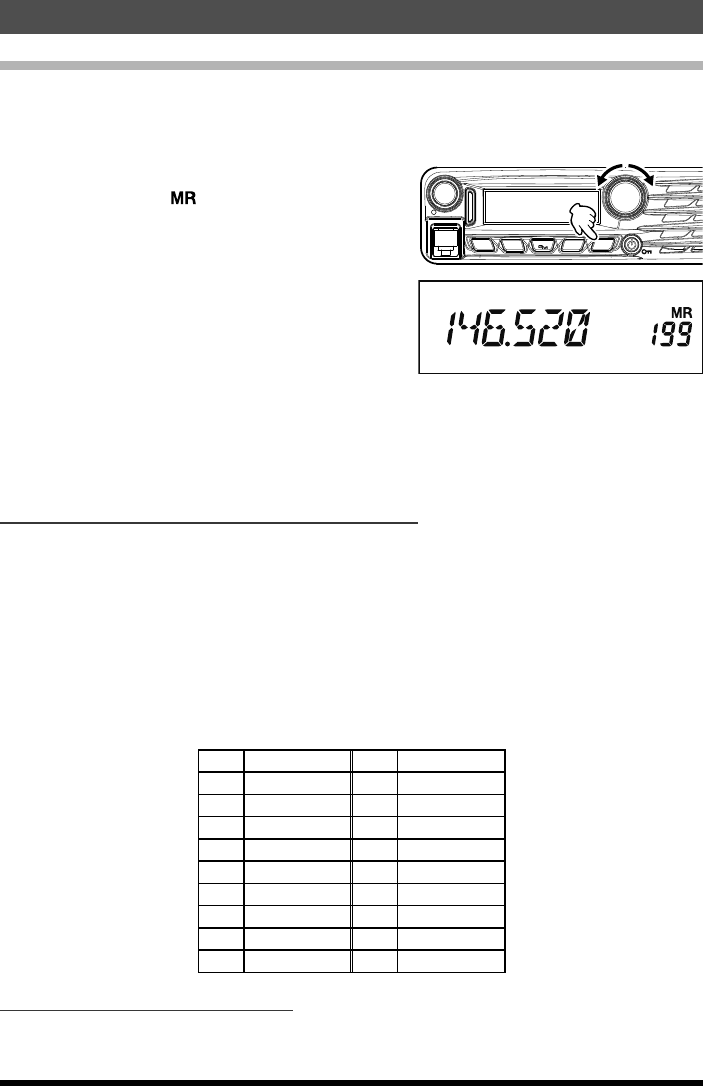
24
Memory Operation
FTM-3200DR Operating Manual
Memory Recall
Once you have stored the memory or memories desired, you must now switch from the
“VFO” mode to the “Memory Recall” mode, so you can operate on the just-stored memory
channels.
1. Press the [V/M(MW)] key, repeatedly if nec-
essary, until the “ ” icon and a memory
channel number appear on the display; this
indicates that the “Memory Recall” mode is
now engaged.
2. When more than one memory has been
stored, use the DIAL knob to select any of
the programmed memories for operation.
VOL
DIAL
SQL
TXPO DW MW
SETUP
REV D/A V/MMHz
Note: Alternatively, the microphone’s [UP] or [DWN] button may be used to step or scan
through the available memories. When using the microphone’s buttons, press the
button momentarily to move one step up or down; press and hold in the [UP] or
[DWN] button for one second to begin memory scanning.
Memory Recall from the Microphone’s Keypad
While operating in the Memory Recall mode, the keypad of the MH-48A6J Microphone
may be used for direct recall of memory channels.
To do this, press the Channel Number you wish to recall, then press the [#] key.
For example:
To recall Memory Channel “5”, press [5] à [#]
To recall Memory Channel “123”, press [1] à [2] à [3] à [#]
You may also recall Programmable Memory Scan (PMS) channels (“L0/U0” through “L9/
U9”) using the following numbers:
L1 201 L6 211
U1 202 U6 212
L2 203 L7 213
U2 204 U7 214
L3 205 L8 215
U3 206 U8 216
L4 207 L9 217
U4 208 U9 218
L5 209 L0 219
U5 210 U0 220
Moving Memory Data to the VFO
Data stored on memory channels can easily be moved to the VFO.
Note: For details, refer to the Advanced Manual (download from the Yaesu website).
Application for FCC / IC
FCC ID: K6620523X50 / IC: 511B-20523X50
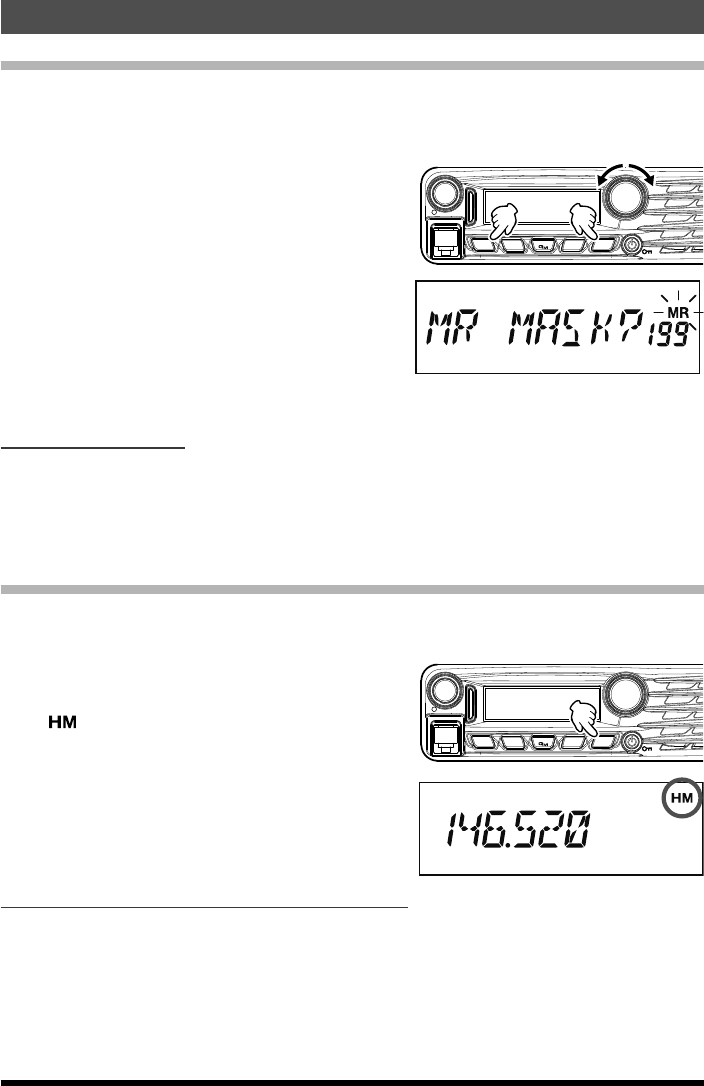
25
Memory Operation
FTM-3200DR Operating Manual
Masking Memories
There may be situations where you want to “Mask” memories so they are not visible during
memory selection or scanning. (except for Memory Channel “1”, the Priority Channel, and
the Home Channel).
1. In the Memory Recall mode, press and hold
in the [V/M(MW)] key for 1 second, then
rotate the DIAL knob to select the memory
channel you wish to mask.
3. Press the [SQL(TXPO)] key.
The erase confirmation screen appears.
4. Press the [SQL(TXPO)] key.
The previously selected memory will be
“masked”.
VOL
DIAL
SQL
TXPO DW MW
SETUP
REV D/A V/MMHz
Note: Press the
[V/M(MW)] key to cancel the memory mask.
Un Masking Memory
1. To Unmask a hidden memory, in the Memory Recall mode, press and hold in the
[V/M(MW)] key for 1 second.
2. Rotate the DIAL knob to select the masked memory’s number.
3. Press the [SQL(TXPO)] key to restore the memory channel’s data.
HOME Channel Memory
A convenient one-touch “Home” channel memory is available to simplify return to your
most often used frequency.
To recall the Home channel, just press the
[V/M(MW)] key, repeatedly if necessary, until
the “ ” icon appears on the display; this
indicates that the Home Channel has been
recalled.
Note: When shipped from factory, the Home
Channel set to 146.520 MHz (USA
version) or 144.000 MHz (EXP version).
VOL
DIAL
SQL
TXPO DW MW
SETUP
REV D/A V/MMHz
Changing the frequency of the home channel
The default frequency setting of the home channel can be changed.
1. In the VFO mode, tune to the desired Home channel frequency.
2. Press and hold in the [V/M(MW)] key for 1 second, then press the [REV(DW)] key.
The overwrite confirmation screen appears.
4. Press the [REV(DW)] key.
The home channel frequency is overwritten.
Application for FCC / IC
FCC ID: K6620523X50 / IC: 511B-20523X50
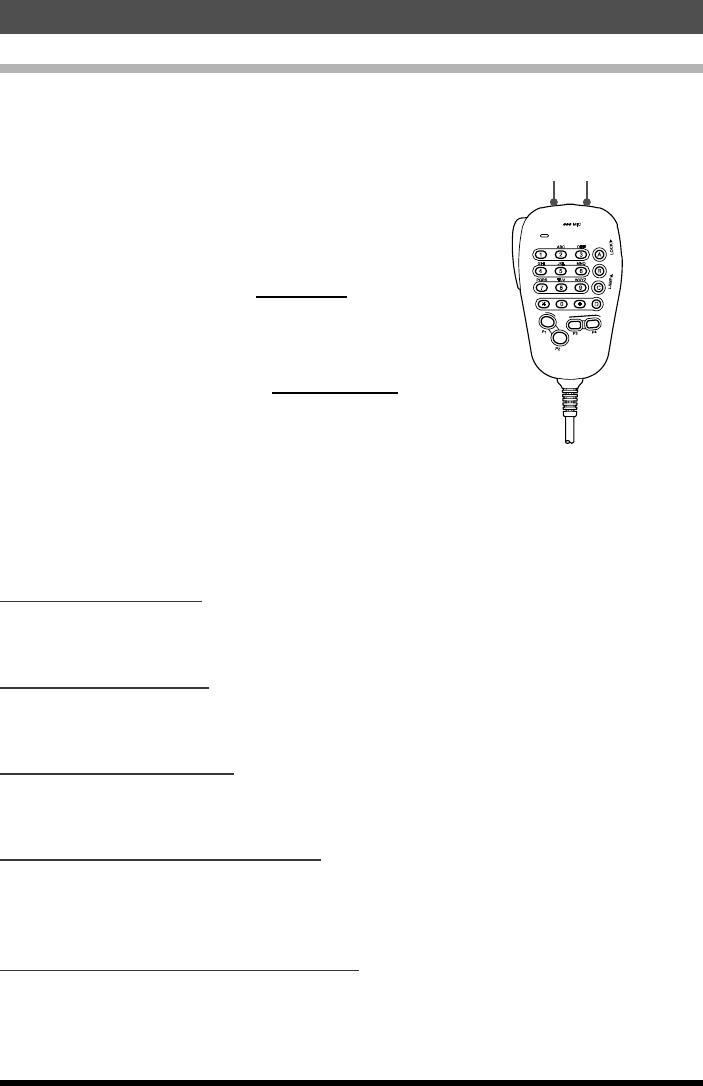
26 FTM-3200DR Operating Manual
Scanning
Basic Scanner Operation
Before activating the scanner, make sure that the Squelch is set to silence the back
ground noise when no signal is present. Scanning is not possible while the Squelch is
open (if noise or signals are being heard).
Scanning may be started or stopped using the micro-
phone’s [UP] or [DWN] button.
The following techniques are used for scanning:
r Pressing and holding in either the [UP] or [DWN]
button for one second in the VFO mode will cause
upward or downward band scanning, respectively,
to begin.
r Pressing and holding in either the [UP] or [DWN]
button for one second in the Memory mode will
cause memory channel scanning toward a higher-
or lower-numbered memory channel, respectively.
LOCK
P3
P2
P1
7
1
4
8
2
0
5
9
B
A
C
D
3
6
P4
LAMP
DTMF MICROPHONE
MH-48
ABC
JKL
TUV
GHI
PQRS
DEF
MNO
WXYZ
MIC
DWN UP
r Scanning pauses when a signal opens the squelch, and the decimal point on the
display will blink. You can choose one of three scan-resume modes (described later).
r
To halt the scan manually, the easiest way is to push the PTT switch on the microphone
momentarily (no transmission will occur while you are scanning). The scan may also be
halted manually by pressing the microphone’s [UP] or [DWN] button, or the [V/M(MW)] key.
Scan Resume Options
Select one of the 3 scan resume modes to be performed after the scanning stops.
Note: For details, refer to the Advanced Manual (download from the Yaesu website).
Memory Skip Scanning
Memory channels which you do not want to receive can be skipped during scanning.
Note: For details, refer to the Advanced Manual (download from the Yaesu website).
Preferential Memory Scan
Set up a “Preferential Scan List” of channels which you can “flag” within the memory system.
Note: For details, refer to the Advanced Manual (download from the Yaesu website).
Programmable Memory Scan (PMS)
Using the dedicated PMS memory channels, only the frequencies within the specified
frequency range will be scanned.
Note: For details, refer to the Advanced Manual (download from the Yaesu website).
Priority Channel Scanning (Dual Watch)
Scanning features include a two-channel scanning capability which allows you to operate
on a VFO, Memory channel, or Home channel, while periodically checking a user defined
Memory Channel for activity.
Note: For details, refer to the Advanced Manual (download from the Yaesu website).
Application for FCC / IC
FCC ID: K6620523X50 / IC: 511B-20523X50
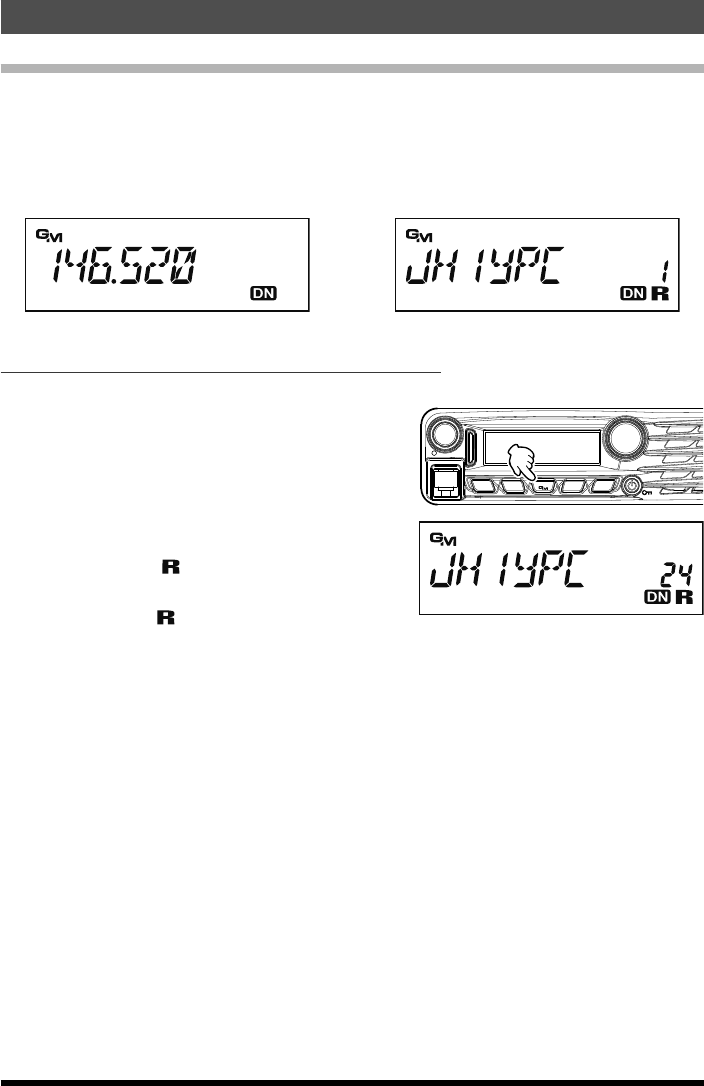
27FTM-3200DR Operating Manual
GM Function
What is the GM (Group Monitor) Function?
The GM function automatically monitors for any other stations with the GM function in
operation on the same frequency, or stations transmitting in DN mode, within communica-
tion range. In addition to notifying you of the group members within your communication
range, the GM function also displays the detected call sign on the transceiver screen.
Caution: The GM function does not work while in the analog (FM) mode.
à
Displaying all the stations using the GM function
1. Tune to the designated frequency.
2. Press and hold in the [D/A(GM)] key for 1
second.
The GM function activates and displays up
to 24 stations using the GM mode on the
same frequency, or stations operating in DN
mode, within the communication range.
Note: Displays “ ”for stations within your
communication range.
Displays “ ” (blinks) for stations out-
side your communication range.
VOL
DIAL
SQL
TXPO DW MW
SETUP
REV D/A V/MMHz
3. Press and hold in the [D/A(GM)] key for 1 second to disable the GM function and return
to the frequency screen.
Application for FCC / IC
FCC ID: K6620523X50 / IC: 511B-20523X50
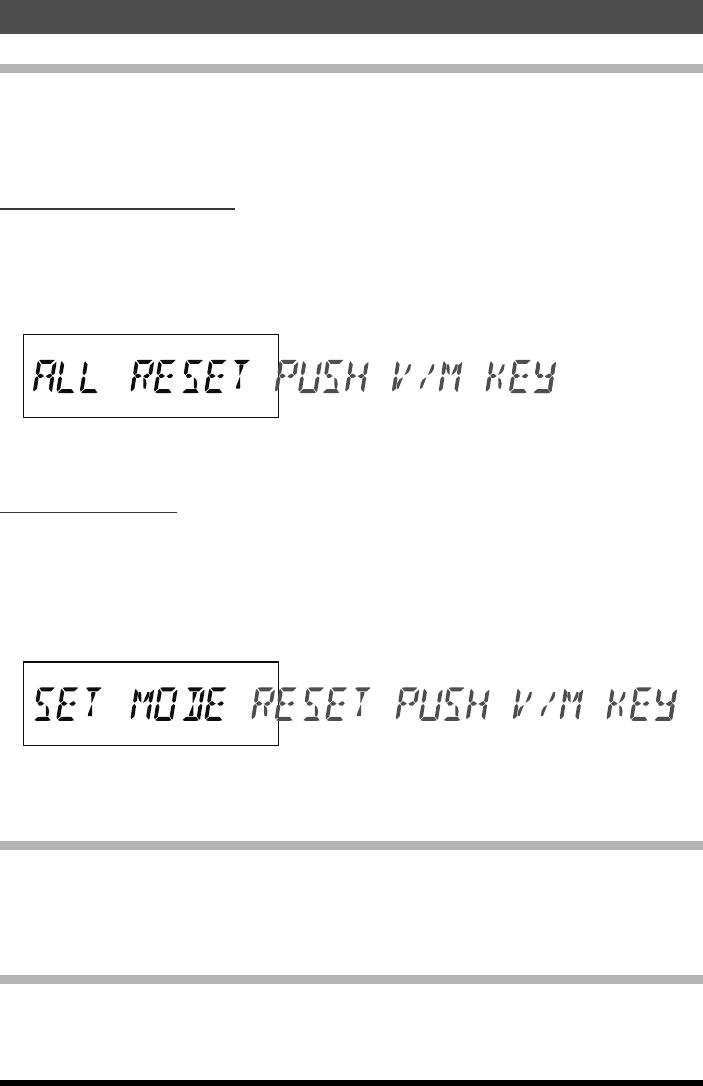
28 FTM-3200DR Operating Manual
Miscellaneous Settings
Reset Procedure
In some instances of erratic or unpredictable operation, the cause may be corruption of
data in the microprocessor (due to static electricity, etc.). If this happens, resetting of the
micro processor may restore normal operation. Note that all memories will be erased if
you do a complete microprocessor reset, as described below.
Microprocessor Resetting
To clear all memories and other settings to factory defaults:
1. Turn the radio off.
2. Press and hold in the [D/A(GM)], [MHz(SETUP)], and [V/M(MW)] keys while turning
the radio on. The “ALL RESET PUSH V/M KEY” notation will scroll on the display.
3. Press the [D/MR(MW)] key momentarily to reset all settings to their factory defaults(-
press any other key to cancel the Reset procedure).
Set Mode Resetting
To reset the Set (Menu) mode settings to their factory defaults, while leaving other settings
unchanged:
1. Turn the radio off.
2. Press and hold in the [D/A(GM)] and [MHz(SETUP)] keys while turning the radio on.
The “SET MODE RESET PUSH V/M KEY” notation will scroll on the display.
3. Press the [D/MR(MW)] key momentarily to reset the Set (Menu) mode settings to their
factory defaults (press any other key to cancel the Reset procedure).
Programming the Key Assignments
Default FTM-3200DR key functions have been assigned to the Microphone’s [P1]/[P2]/
[P3]/[P4] keys at the factory. These may be changed by the user, if you wish to assign
quick access to another function.
Note: For details, refer to the Advanced Manual (download from the Yaesu website).
Keyboard Beeper
A key/button beeper provides useful audible feedback whenever a key/button is pressed.
If you want to turn the beeper off (or back on again).
Note: See Setup Menu Item “BEP KEY 3” on page xx.
Application for FCC / IC
FCC ID: K6620523X50 / IC: 511B-20523X50
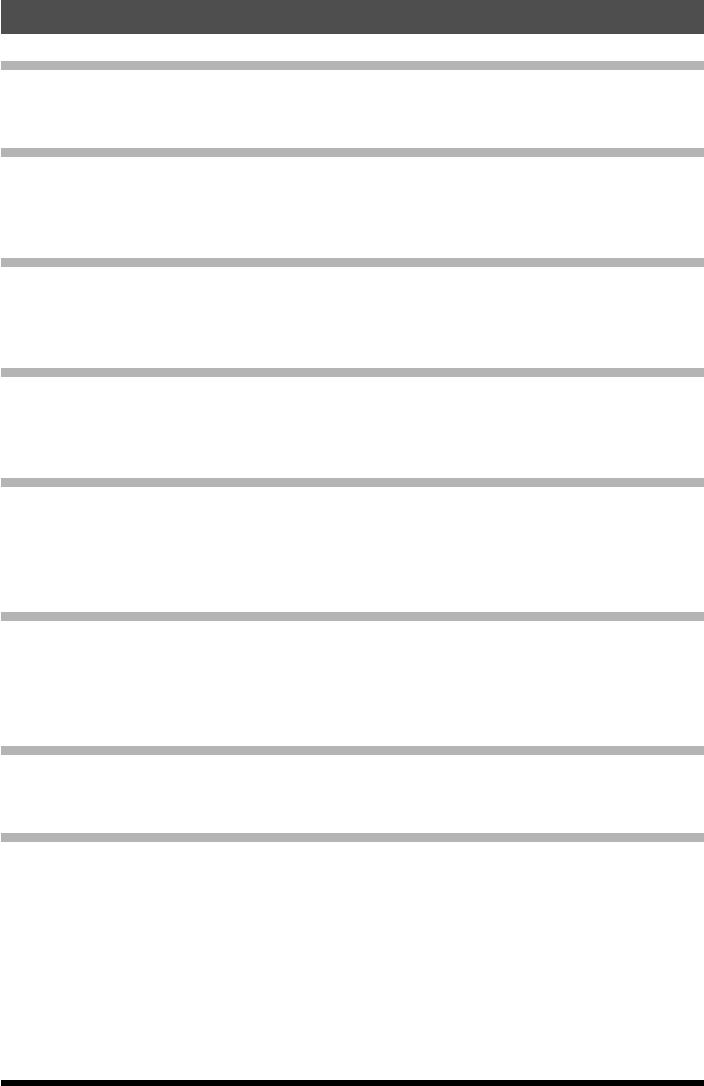
29
Miscellaneous Settings
FTM-3200DR Operating Manual
Display Brightness
You can adjust the display brightness.
Note: See Setup Menu Item “LCD DMMR 22” on page xx.
Time-Out-Timer (TOT)
The “Time-Out Timer” (TOT) feature is designed to force the transceiver into the “receive”-
mode after a preset time period of continuous transmission (the default is 3 minutes).
Note: See Setup Menu Item “TOT 46” on page xx.
Automatic Power Off (APO)
The “Automatic Power-Off” (APO) feature will turn the radio completely off after a user
defined period of PTT or key/button inactivity.
Note: See Setup Menu Item “APO 1” on page xx.
Busy Channel Lock-Out (BCLO)
The BCLO feature prevents the radio’s transmitter from being activated if a signal strong
enough to break through the “noise” squelch is present.
Note: See Setup Menu Item “BCLO 2” on page xx.
TX Deviation Level
You can reduce the receiver bandwidth and microphone deviation level when operating
on tightly-clustered frequencies (channel spacing of 12.5 or 15 kHz). This will reduce the
transmitter deviation, thus minimizing interference to other users.
Note: See Setup Menu Item “W/N DEV 52” on page xx.
MIC Gain Setting
At the factory, a microphone gain has been programmed that should be satisfactory for
the supplied MH-48A6J Microphone. If you use an after-market microphone or connect a
TNC, you may wish to set a different Mic Gain level.
Note: See Setup Menu Item “MIC GAIN 24” on page xx.
Displaying the Supply Voltage
Display the Power Supply voltage.
Note: See Setup Menu Item “DC VOLT 8” on page xx.
Displaying the Temperature
Indicates indicate the current temperature inside the transceiver’s case.
Note: See Setup Menu Item “TEMP 44” on page xx.
Application for FCC / IC
FCC ID: K6620523X50 / IC: 511B-20523X50

30 FTM-3200DR Operating Manual
Packet Operation
The FTM-3200R may be used for 1200 bps Packet operation, using most all commonly
available Terminal Node Controllers (TNCs). Connections between the transceiver and
the TNC are accomplished via the front panel Microphone connector and rear panel
External Speaker jack, per the diagram below.
The audio level from the receiver to the TNC may be adjusted by using the VOL knob, as
with voice operation. The input level to the FTM-3200R from the TNC may be adjusted via
Setup Menu Item “MIC GAIN 24” see page xx for details.
Be sure to turn the transceiver and TNC off before connecting the cables, so as to prevent
voltage spikes from possibly damaging your transceiver.
Remember to readjust the default microphone input level to “LEVEL 5” (Setup Menu Item
“MIC GAIN 24”) when Packet operation is finished.
Application for FCC / IC
FCC ID: K6620523X50 / IC: 511B-20523X50

31FTM-3200DR Operating Manual
Cloning
The FTM-3200R includes a convenient “Clone” feature, which allows the memory and
configuration data from one transceiver to be transferred to another FTM-3200R.
This can be particularly useful when configuring a number of transceivers for a public
service operation.
Here is the procedure for Cloning one radio’s data to another:
1. Turn both radios off.
2. Connect the user-constructed cloning cable between the MIC jacks of the two radios.
3. Press and hold in the [LOW(A/N)] key while turning the radios on. Do this for both ra-
dios (the order of switch-on does not matter). “CLONE” will appear on the displays of
both radios when the Clone mode is successfully activated in this step.
4. On the Destination radio, press the [D/MR(MW)] key (“- -WAIT- -” will appear on the
LCD).
5. Press the [MHz(SET)] key on the Source radio; “- - - -TX- - - -” will appear on the
Source radio, and the data from this radio will be transferred to the other radio.
6. If there is a problem during the cloning process, “ERROR” will be displayed. Check
your cable connections and battery voltage, and try again.
7. If the data transfer is successful, “CLONE” will appear on both displays.
8. Press any key to exit to normal operation.
9. Turn both radios off and disconnect the cloning cable.
Application for FCC / IC
FCC ID: K6620523X50 / IC: 511B-20523X50
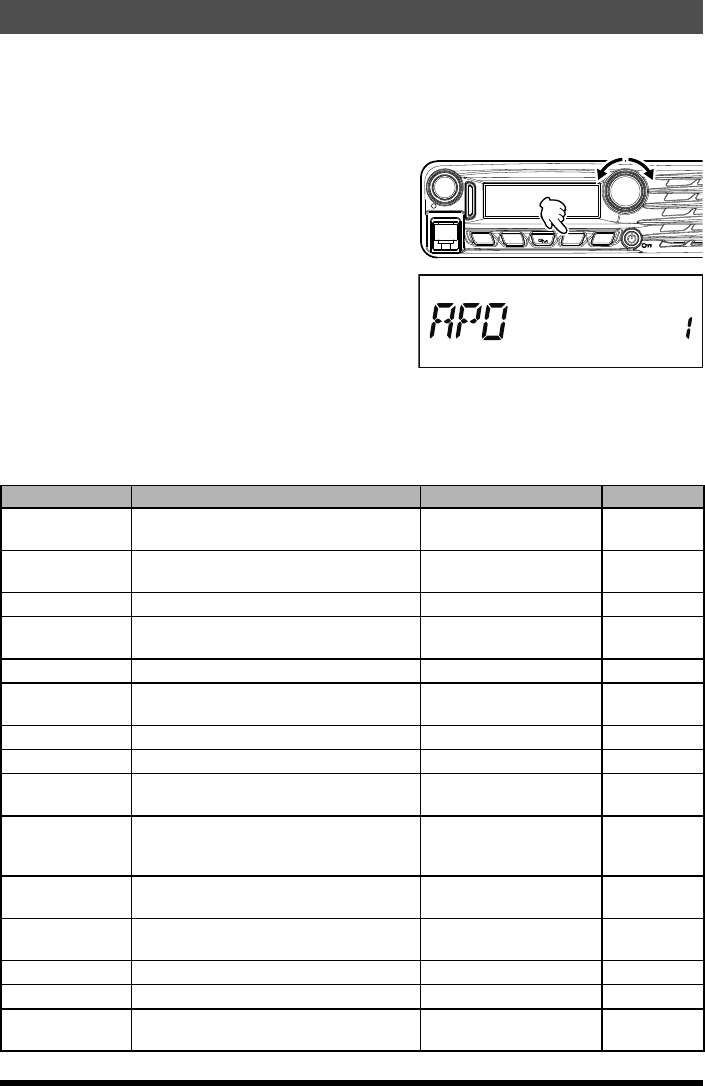
32 FTM-3200DR Operating Manual
Setup (Menu) Mode
The FTM-3200R Setup (Menu) mode, already described in parts of many previous
chapters, is easy to activate and set. It may be used for configuration of a wide variety
of transceiver parameters, some of which have not been detailed previously. Use the
following procedure to activate the Setup (Menu) mode:
1. Press and hold in the [MHz(SETUP)] key for
1 second to enter the Setup menu.
2. Rotate the DIAL knob to select the Menu
Item to be adjusted.
3. Press the [MHz(SETUP)] key momentarily
to enable adjustment of the selected Menu
item, then rotate the DIAL knob to perform
the actual adjustment.
4. After completing your selection and adjust-
ment, press and hold in the [MHz(SETUP)]
key for 1 second to exit the Setup menu and
resume normal operation.
VOL
DIAL
SQL
TXPO DW MW
SETUP
REV D/A V/MMHz
Menu Item Function Available Values Default
1: APO Enables/Disables the Automatic Power
Off feature.
0.5H to 12H (0.5H step)/
OFF OFF
2: BCLO Enables/Disables the Busy Channel
Lock-Out feature. ON/OFF OFF
3: BEP KEY Enables/Disables the key beeper. KEY+SCAN/KEY/OFF KEY+SCAN
4: BEP EDGE Enables/Disable the Band-edge beeper
while scanning. ON/OFF OFF
5: BEP STBY Enables/Disable the Standby beep ON/OFF ON
6: BELL Selects the CTCSS/DCS/EPCS Bell
Ringer repetitions. 1 to 20/CONTINUE/OFF OFF
7: CLK TYPE Shifting of the CPU clock frequency. A/B A
8: DC VOLT Indicates the DC Supply Voltage. --- ---
9: DCS CODE Setting of the DCS code. 104 standard DCS
codes 023
10: DCS INV
Select a combination of DCS inversion
codes in terms of communication direc-
tion.
NORMAL/INVERT/
BOTH NORMAL
11: DIG AMS Sets the transmission mode TXMANUAL/TX FMFIX/
TX DNFIX/AUTO TXMANUAL
12: DI POPUP Sets the information pop-up time 2/4/6/8/10/20/30/60/
CONTINUE/OFF 10 SEC
13: DSQ CODE Sets the squelch code in digital mode. 001 to 126 CODE 001
14: DSQ TYPE Sets the squelch type in digital mode. OFF/CODE/BREAK OFF
15: DT AUTO Enables/Disables the DTMF Autodialer
feature. MANUAL/AUTO MANUAL
Application for FCC / IC
FCC ID: K6620523X50 / IC: 511B-20523X50

33
Setup (Menu) Mode
FTM-3200DR Operating Manual
Menu Item Function Available Values Default
16: DT DELAY Setting of the DTMF Autodialer’s TX De-
lay Time. 50/250/450/750/1000 450 MS
17: DT SET Loading of the DTMF Autodialer Memo-
ries. --- ---
18: DT SPEED Setting of the DTMF Autodialer Sending
Speed. 50/100 50 MS
19: DW RVRT Enables/Disables the “Priority Channel
Revert” feature. ON/OFF OFF
20: GM RINGR
Enables/Disables the alert sound when
detecting stations within communication
range
IN RANGE
/
ALWAYS
/OFF IN RANGE
21: GM INTVL Selects the automatic sending interval. NORMAL/LONG NORMAL
22: LCD DMMR Setting of the front panel display’s illumi-
nation level. LEVEL 1/2/3/4 LEVEL 4
23: LOCK Selects the Control Locking Lockout
combination.
KEY+DIAL/PTT/
KEY+PTT/DIAL+PTT/
ALL/KEY/DIAL
KEY+DIAL
24: MIC GAIN Adjust the microphone gain level. LEVEL 5 to 9 LEVEL 5
25: MEM NAME Programming an Alpha/Numeric label for
a Memory Channel. --- ---
26: MW MODE Selects the method of selection of chan-
nels for Memory Storage. NEXT CH/LOWER CH NEXT CH
27: OPEN MSG Selects the Opening Message that ap-
pears when the radio is powered ON. OFF/DC/MESSAGE MESSAGE
28: PAG CD-R
Setting the Receiver Pager Code for
the Enhanced CTCSS Paging & Code
Squelch function.
--- 05 47
29: PAG CD-T
Setting the Transmitting Pager Code for
the Enhanced CTCSS Paging & Code
Squelch function.
--- 05 47
30: PAG P1 Programming the function assigned to
Microphone’s [P1] key.
SQL OFF
HOME
WX CH
CD SRCH
SCAN
T CALL
TX POWER
DIG/ANA
GM
Setup Menu Item #1 to
53
SQL OFF
31: PAG P2 Programming the function assigned to
Microphone’s [P2] key. HOME
32: PAG P3 Programming the function assigned to
Microphone’s [P3] key. CD SRCH
33: PAG P4 Programming the function assigned to
Microphone’s [P4] key.
Depends on
the transceiv-
er version.
34: RADIO ID Displays the transceiver IDs øøø (uneditable) ---
35: RF SQL Adjusts the RF Squelch threshold level. ON/OFF OFF
36: RPT ARS Activates/Deactivates the Automatic Re-
peater Shift feature. ON/OFF ON
37: RPT FREQ Sets the magnitude of the Repeater Shift. 0.00 - 99.95 (MHz) 0.60 MHz
38: RPT SFT Sets the Repeater Shift direction. -RPT/+RPT/SIMP SIMP
39: SCAN RSM Selects the Scan Resume mode.
BUSY
/
HOLD
/2-10 (SEC) 5.0 SEC
Application for FCC / IC
FCC ID: K6620523X50 / IC: 511B-20523X50

34
Setup (Menu) Mode
FTM-3200DR Operating Manual
Menu Item Function Available Values Default
40: SCAN SKP Selects the Memory Scan mode. OFF/SKIP/SELECT OFF
41: SQL EXP Sets the squelch type separately for
transmission and reception. ON/OFF OFF
42: SQL TYPE Selects the Tone Encoder and/or Decod-
er mode.
TONE/TSQ/DCS/RV
TONE/PAG/OFF OFF
43: STEP Sets the Synthesizer steps. AUTO/5/6.25/10/12.5/15
/20/25/50/100 (Hz) AUTO
44: TEMP Indicats the current temperature inside
the transceiver’s case. F/C USA: F
EXP: C
45: TONE FRQ Setting of the CTCSS Tone Frequency. 67.0 to 254.1 (Hz) 100.0 HZ
46: TOT Sets the Time-Out Timer. 0.5 to 10.0 (MIN) 3.0 MIN or
OFF
47: TS MUTE
Enables/Disables the receiver audio out-
put during the Tone Search Scanner is
activated.
ON/OFF ON
48: TS SPEED Selects the Tone Search Scanner speed. FAST/SLOW FAST
49: VER DISP Displays the transceiver software version CPU x.xx
DSP x.xx ---
50: WX ALERT Enables/Disables the Weather Alert fea-
ture. ON/OFF OFF
51: WX VOL Selects the audio output level of the
Weather Alert. NOR.VOL/MAX.VOL NOR VOL
52: W/N DEV Reduction of the Microphone Gain/Devia-
tion and receiver bandwidth. WIDE/NARROW WIDE
53: MY CALL Sets your station call sign øøøøøøøøøø ---
Application for FCC / IC
FCC ID: K6620523X50 / IC: 511B-20523X50

35FTM-3200DR Operating Manual
Specifications
General
Frequency Range: Tx 144 - 148 MHz
Rx 136 - 174 MHz
Channel Step: 5/6.25/10/12.5/15/20/25/50/100 kHz
Standard Repeater Shift: ±600 kHz
Frequency Stability: ±2.5 ppm [-4 °F to +140 °F (-20 °C to +60 °C)]
Modes of Emission: F3E/F7W
Antenna Impedance: 50 Ohms, unbalanced
Supply voltage: 13.8 V DC ±15 %, negative ground
Current Consumption (typical): Rx: less than 0.7 A, less than 0.5 A (squelched)
Tx: 15 A (65 W) /10 A (30 W) /5 A (5 W)
Operating Temperature Range: -4° F to +140° F (-20° C to +60° C)
Case Size (WxHxD): 6.1” x 1.7” x 6.1” (154 x 43 x 155 mm) (w/o knobs)
Weight (Approx.): 2.86 lb (1.3 kg)
Transmitter
Output Power: 65/30/5 W
Modulation Type: F3E: Variable Reactance
F7W: 4FSK (C4FM)
Maximum Deviation: ±5 kHz (Wide)
±2.5 kHz (Narrow)
Spurious Radiation: Better than -60 dB
Microphone Impedance: 2 k Ohms
Receiver
Circuit Type: Double Conversion Superheterodyne
Ifs: 1st 47.25 MHz, 2nd 450 kHz
Sensitivity (for 12dB SINAD): 0.20 μV (Ham band, wide)
0.22 μV (Ham band, narrow)
Sensitivity (for Digital): 0.22 μV (BER 1 %)
Selectivity (–6/–60dB): 12 kHz/28 kHz
Maximum AF Output: 3 W @ 13.8 V, 10 % THD (EXP SP)
Rated values are at normal temperature and pressure.
Ratings and specifications are subject to change without notice.
Application for FCC / IC
FCC ID: K6620523X50 / IC: 511B-20523X50

36
Specifications
FTM-3200DR Operating Manual
1. Changes or modifications to this device not expressly approved by YAESU MUSEN could void the
user’s authorization to operate this device.
2. This device complies with part 15 of the FCC Rules. Operation is subject to the following two
conditions: (1) This device may not cause harmful interference, and (2) this device must accept any
interference including received, interference that may cause undesired operation.
3. The scanning receiver in this equipment is incapable of tuning, or readily being altered, by the User
to operate within the frequency bands allocated to the Domestic public Cellular Telecommunications
Service in Part 22.
This device complies with Industry Canada license-exempt RSS standard(s). Operation is subject
to the following two conditions: (1) this device may not cause interference, and (2) this device must
accept any interference, including interference that may cause undesired operation of the device.
Le présent appareil est conforme aux CNR d’Industrie Canada applicables aux appareils radio
exempts de licence. L’exploitation est autorisée aux deux conditions suivantes : (1) l’appareil ne doit
pas produire de brouillage, et (2) l’utilisateur de l’appareil doit accepter tout brouillage radioélectrique
subi, même si le brouillage est susceptible d’en compromettre le fonctionnement.
DECLARATION BY MANUFACTURER
The Scanner receiver is not a digital scanner and is incapable of being converted or modified to a
digital scanner receiver by any user.
WARNING: MODIFICATION OF THIS DEVICE TO RECEIVE CELLULAR RADIOTELEPHONE
SERVICE SIGNALS IS PROHIBITED UNDER FCC RULES AND FEDERAL LAW.
CAN ICES-3 (B) / NMB-3 (B)
Application for FCC / IC
FCC ID: K6620523X50 / IC: 511B-20523X50

Copyright 2016
YAESU MUSEN CO., LTD.
All rights reserved.
No portion of this manual
may be reproduced
without the permission of
YAESU MUSEN CO., LTD.
Printed in Japan
1601A-0O
*EH052N100*
EH052N100
YAESU MUSEN CO., LTD.
Tennozu Parkside Building
2-5-8 Higashi-Shinagawa, Shinagawa-ku, Tokyo 140-0002 Japan
YAESU USA
6125 Phyllis Drive, Cypress, CA 90630, U.S.A.
YAESU UK
Unit 12, Sun Valley Business Park, Winnall Close
Winchester, Hampshire, SO23 0LB, U.K.
Application for FCC / IC
FCC ID: K6620523X50 / IC: 511B-20523X50
User Manual - 2
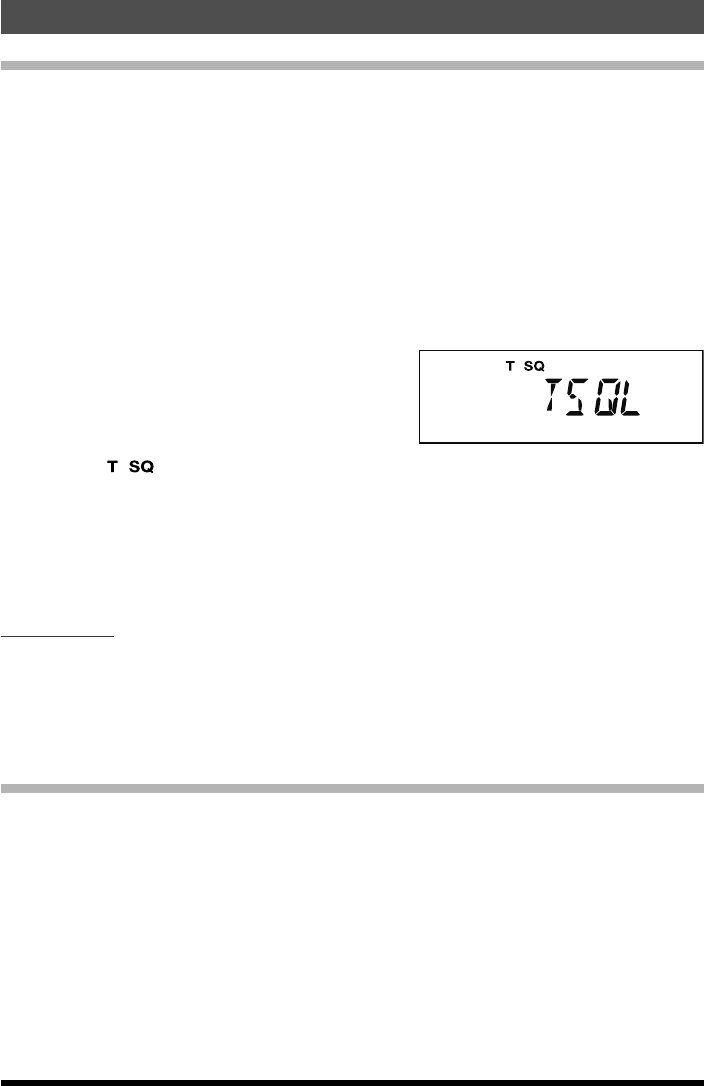
21
Advanced Operation
FTM-3200DR Operating Manual
CTCSS Operation
This radio is equipped with the CTCSS (Continuous Tone-coded Squelch System which
allows audio to be heard only when receiving signals containing the same frequency tone
as the tone that has been set in the tone squelch menu. By matching the tone frequency
with the partner station in advance, a quiet standby monitoring is possible.
Caution: CTCSS does not function in digital mode. To transmit a signal using a CTCSS
code, use the [D/A(GM)] key to switch the communication mode to AMS (Auto
Mode Select function) or analog (FM) mode.
1. Press and hold in the [MHz(SETUP)] key for over 1 second.
The Setup menu appears.
2. Rotate the DIAL knob to select “SQL TYPE 42”, then press the [MHz(SETUP)] key.
3. Rotate the DIAL knob to select “TSQL”, then
press and hold in the [MHz(SETUP)] key for
over 1 second.
Displays “ ” on the screen. The squelch opens only when receiving tone signals
of the set frequency.
Note: From the Setup Menu, you can change the CTCSS setting.
TONE FRQ 45 à The tone frequency can be selected from 50 frequencies.
BELL 6 à A bell tone (beep) may be set to sound when signals containing
a corresponding CTCSS tone are received.
Tone Search
In operating situations where you don’t know the CTCSS tone being used by another
station or stations, you can command the radio to listen to the incoming signal and scan
in search of the tone being used.
Note: For details, refer to the Advanced Manual (download from the Yaesu website).
DCS Operation
This radio is equipped with a DCS (Digital Coded Squelch) function that allows audio to
be heard only when signals containing the corresponding DCS code are received. By
matching the DCS code with the partner stations beforehand, a quiet receive standby is
possible.
Caution: DCS does not function in digital mode. To transmit a signal with a DCS code,
use the [D/A(GM)] key to switch the communication mode to AMS (Auto Mode
Select function) or analog (FM) mode.
1. Press and hold in the [MHz(SETUP)] key for over 1 second.
The Setup menu appears.
2. Rotate the DIAL knob to select “SQL TYPE 42”, then press the [MHz(SETUP)] key.
Application for FCC / IC
FCC ID: K6620523X50 / IC: 511B-20523X50
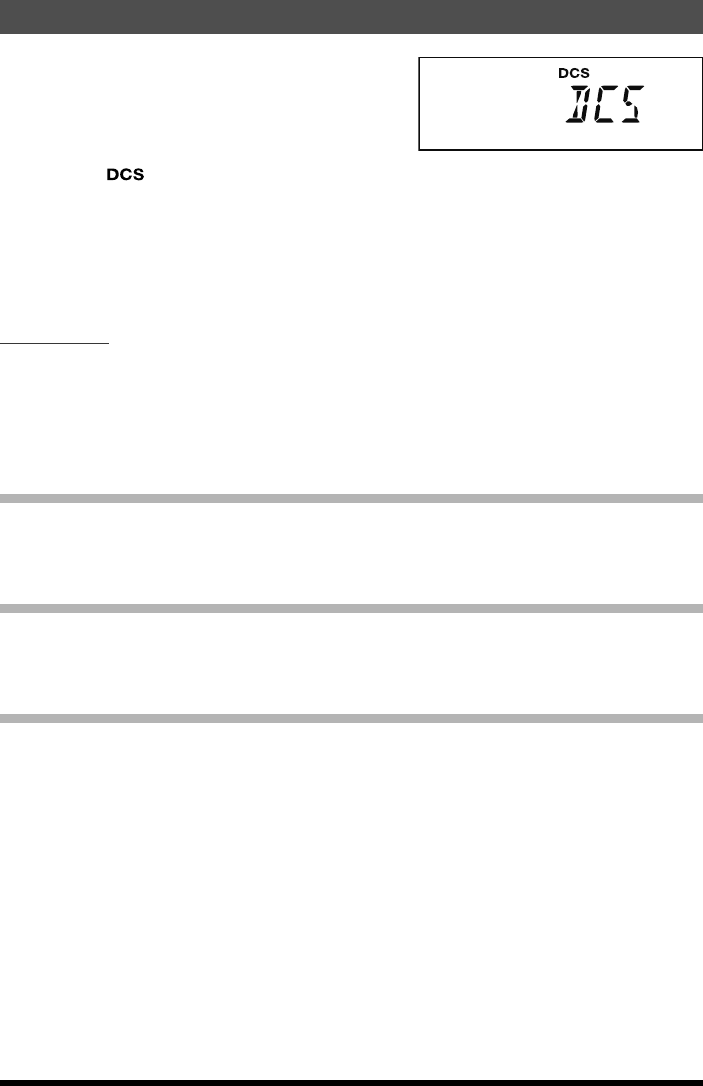
22
Advanced Operation
FTM-3200DR Operating Manual
3. Rotate the DIAL knob to select “DCS”, then
press and hold in the [MHz(SETUP)] key for
over 1 second.
Displays “ ” on the screen. The squelch opens only when receiving a signal con-
taining the corresponding DCS code.
Note: From the Setup Menu, you can change the DCS setting.
DCS CODE 9 à The DCS code can be selected from 104 codes.
BELL 6 à A bell tone (beep) may be set to sound when signals containing
a corresponding DCS code are received.
DCS Search
In operating situations where you don’t know the DCS code being used by another station
or stations, you can command the radio to listen to the incoming signal and scan in search
of the code being used.
Note: For details, refer to the Advanced Manual (download from the Yaesu website).
EPCS (Enhanced Paging & Code Squelch) Operation
Use the pager code consisting of 2 CTCSS tones to exchange communications with
specified stations.
Note: For details, refer to the Advanced Manual (download from the Yaesu website).
Split Tone Operation
The FTM-3200R can be operated in a “Split Tone” configuration, to enable operation on
repeaters using a mix of both CTCSS and DCS control via the Setup menu.
Note: For details, refer to the Advanced Manual (download from the Yaesu website).
DTMF Operation
DTMF tones (Dual Tone Multi Frequencies) are the tones you hear when dialing from a
telephone keypad. The FTM-3200DR transceiver can transmit the DTMF codes by using
the keys on the microphone or recalling registered numbers from memories.
The maximum of 16-digit DTMF codes can be registered in up to 10 memory channels.
It is convenient to register telephone patch numbers, and network linking sequences to
the DTMF memory channels.
Note: For details, refer to the Advanced Manual (download from the Yaesu website).
Application for FCC / IC
FCC ID: K6620523X50 / IC: 511B-20523X50
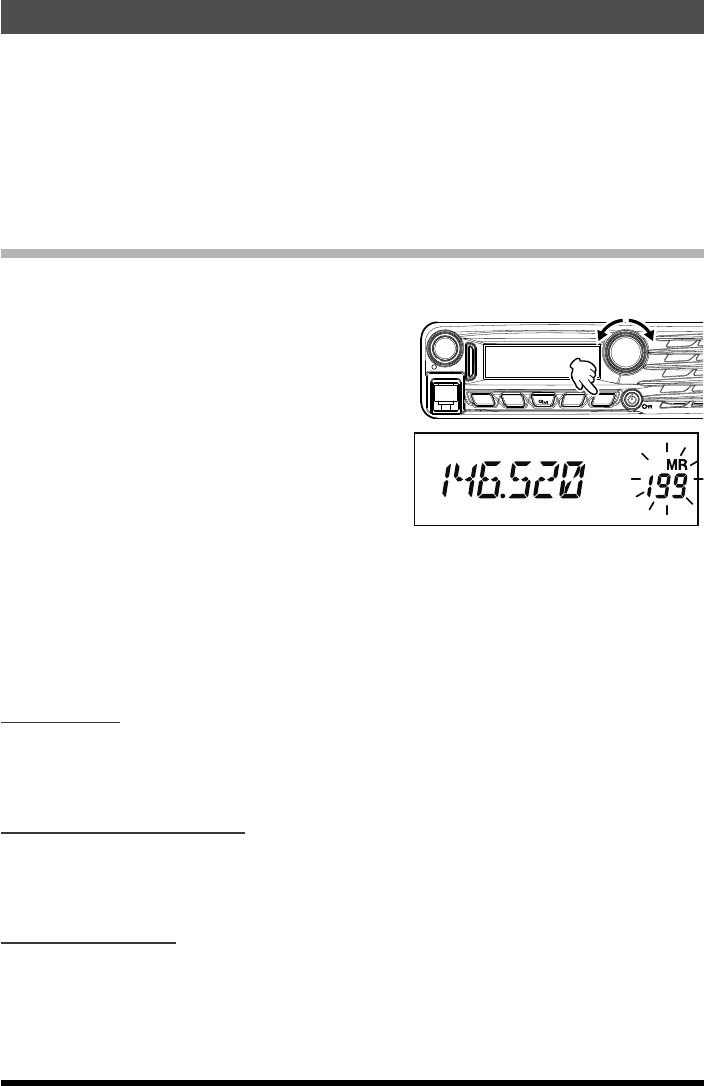
23FTM-3200DR Operating Manual
Memory Operation
The FTM-3200R provides a wide variety of memory system resources. These include:
r 199 “basic” memory channels, numbered “1” through “199”.
r A “Home” channel, providing storage and quick recall of one prime frequency.
r 10 sets of band-edge memories, also known as “Programmable Memory Scan”
channels, labeled “L0/U0” through “L9/U9”.
Each memory may be appended with an alpha-numeric label of up to 8 characters, for
quick channel recognition.
Memory Storage
1. In the VFO mode, select the desired frequency, repeater shift, CTCSS/DCS tone, and
TX power level.
2. Press and hold in the [V/M(MW)] key for 1
second.
A memory number will appear in the bottom
right corner of the display.
Note: If the channel number is blinking,
there currently is no data stored on
that channel; if the channel number is
not blinking, that channel is currently
“occupied” by other frequency data.
VOL
DIAL
SQL
TXPO DW MW
SETUP
REV D/A V/MMHz
3. Within five seconds of pressing the [V/M(MW)] key, use the DIAL knob to select the
desired memory into which you wish to store the frequency.
4. Press the [V/M(MW)] key again, this time momentarily, to store the displayed data into
the selected memory channel slot.
5. To store other frequencies, repeat steps 1 through 4, remembering to set the repeater
shift, CTCSS/DCS tone, and TX power level, as appropriate.
Split Memory
A separate transmit frequency may be registered to a memory channel to which a receive
frequency has already been registered.
Note: For details, refer to the Advanced Manual (download from the Yaesu website).
Naming a Memory Channel
You may wish to append an alpha-numeric “Tag” (label) to a memory or memories, to aid
in recollection of the channel’s use (such as club name, etc.).
Note: For details, refer to the Advanced Manual (download from the Yaesu website).
Memory Only Mode
Once memory channel programming has been completed, you may place the radio in a
“Memory Only” mode, whereby VFO operation is impossible.
Note: For details, refer to the Advanced Manual (download from the Yaesu website).
Application for FCC / IC
FCC ID: K6620523X50 / IC: 511B-20523X50
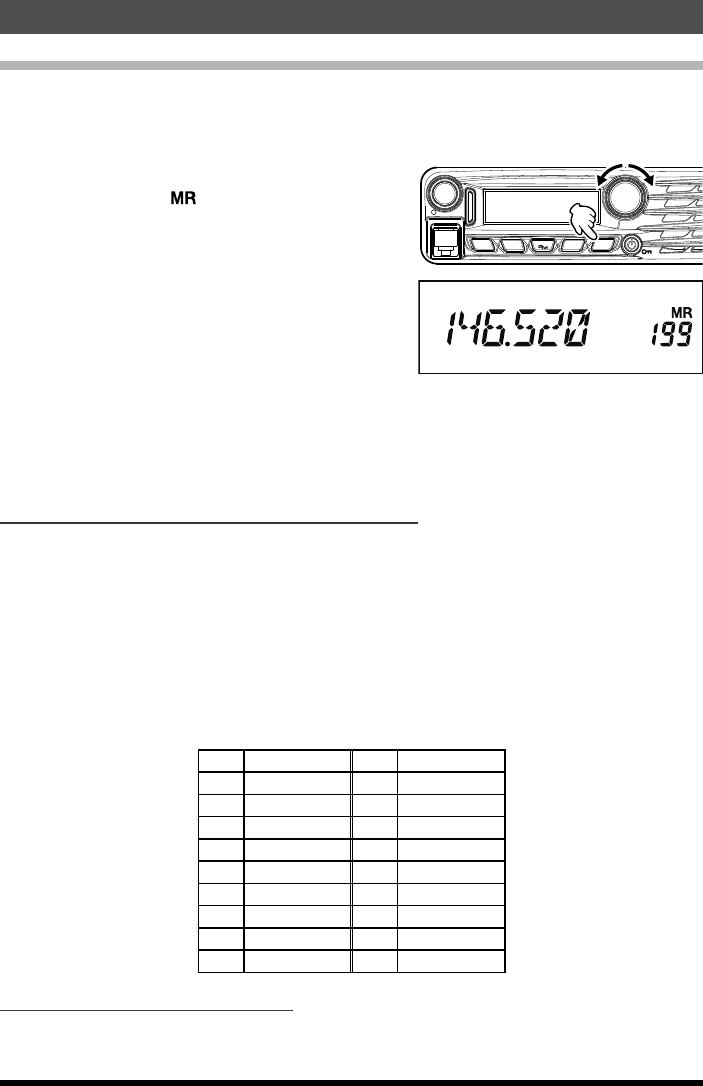
24
Memory Operation
FTM-3200DR Operating Manual
Memory Recall
Once you have stored the memory or memories desired, you must now switch from the
“VFO” mode to the “Memory Recall” mode, so you can operate on the just-stored memory
channels.
1. Press the [V/M(MW)] key, repeatedly if nec-
essary, until the “ ” icon and a memory
channel number appear on the display; this
indicates that the “Memory Recall” mode is
now engaged.
2. When more than one memory has been
stored, use the DIAL knob to select any of
the programmed memories for operation.
VOL
DIAL
SQL
TXPO DW MW
SETUP
REV D/A V/MMHz
Note: Alternatively, the microphone’s [UP] or [DWN] button may be used to step or scan
through the available memories. When using the microphone’s buttons, press the
button momentarily to move one step up or down; press and hold in the [UP] or
[DWN] button for one second to begin memory scanning.
Memory Recall from the Microphone’s Keypad
While operating in the Memory Recall mode, the keypad of the MH-48A6J Microphone
may be used for direct recall of memory channels.
To do this, press the Channel Number you wish to recall, then press the [#] key.
For example:
To recall Memory Channel “5”, press [5] à [#]
To recall Memory Channel “123”, press [1] à [2] à [3] à [#]
You may also recall Programmable Memory Scan (PMS) channels (“L0/U0” through “L9/
U9”) using the following numbers:
L1 201 L6 211
U1 202 U6 212
L2 203 L7 213
U2 204 U7 214
L3 205 L8 215
U3 206 U8 216
L4 207 L9 217
U4 208 U9 218
L5 209 L0 219
U5 210 U0 220
Moving Memory Data to the VFO
Data stored on memory channels can easily be moved to the VFO.
Note: For details, refer to the Advanced Manual (download from the Yaesu website).
Application for FCC / IC
FCC ID: K6620523X50 / IC: 511B-20523X50
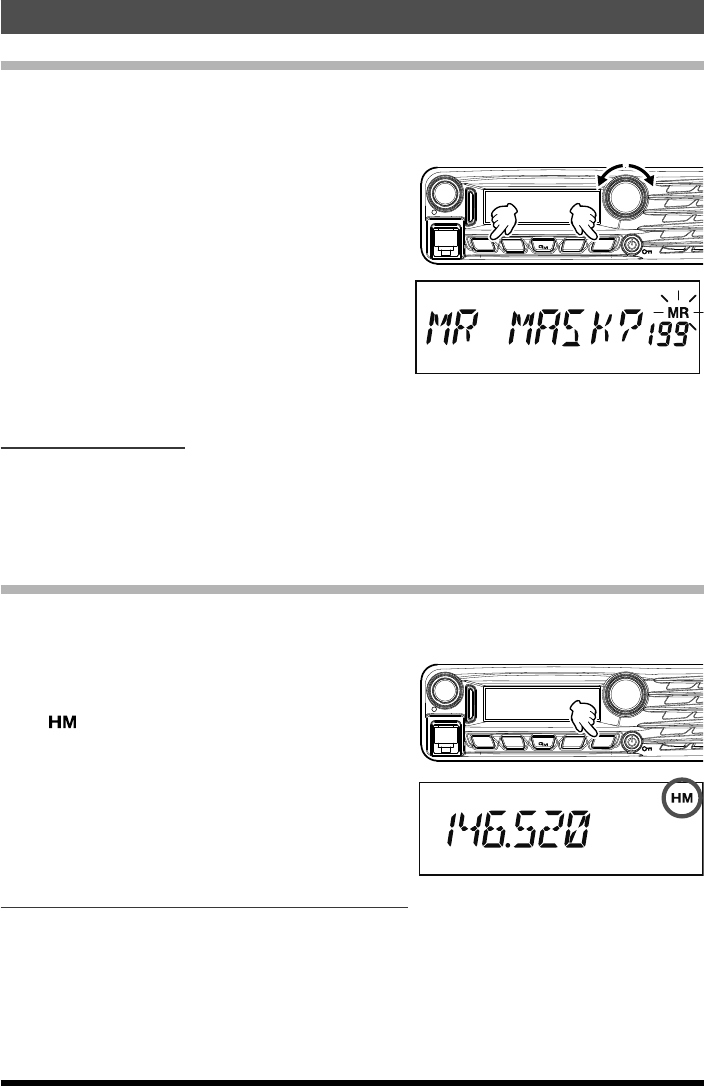
25
Memory Operation
FTM-3200DR Operating Manual
Masking Memories
There may be situations where you want to “Mask” memories so they are not visible during
memory selection or scanning. (except for Memory Channel “1”, the Priority Channel, and
the Home Channel).
1. In the Memory Recall mode, press and hold
in the [V/M(MW)] key for 1 second, then
rotate the DIAL knob to select the memory
channel you wish to mask.
3. Press the [SQL(TXPO)] key.
The erase confirmation screen appears.
4. Press the [SQL(TXPO)] key.
The previously selected memory will be
“masked”.
VOL
DIAL
SQL
TXPO DW MW
SETUP
REV D/A V/MMHz
Note: Press the
[V/M(MW)] key to cancel the memory mask.
Un Masking Memory
1. To Unmask a hidden memory, in the Memory Recall mode, press and hold in the
[V/M(MW)] key for 1 second.
2. Rotate the DIAL knob to select the masked memory’s number.
3. Press the [SQL(TXPO)] key to restore the memory channel’s data.
HOME Channel Memory
A convenient one-touch “Home” channel memory is available to simplify return to your
most often used frequency.
To recall the Home channel, just press the
[V/M(MW)] key, repeatedly if necessary, until
the “ ” icon appears on the display; this
indicates that the Home Channel has been
recalled.
Note: When shipped from factory, the Home
Channel set to 146.520 MHz (USA
version) or 144.000 MHz (EXP version).
VOL
DIAL
SQL
TXPO DW MW
SETUP
REV D/A V/MMHz
Changing the frequency of the home channel
The default frequency setting of the home channel can be changed.
1. In the VFO mode, tune to the desired Home channel frequency.
2. Press and hold in the [V/M(MW)] key for 1 second, then press the [REV(DW)] key.
The overwrite confirmation screen appears.
4. Press the [REV(DW)] key.
The home channel frequency is overwritten.
Application for FCC / IC
FCC ID: K6620523X50 / IC: 511B-20523X50
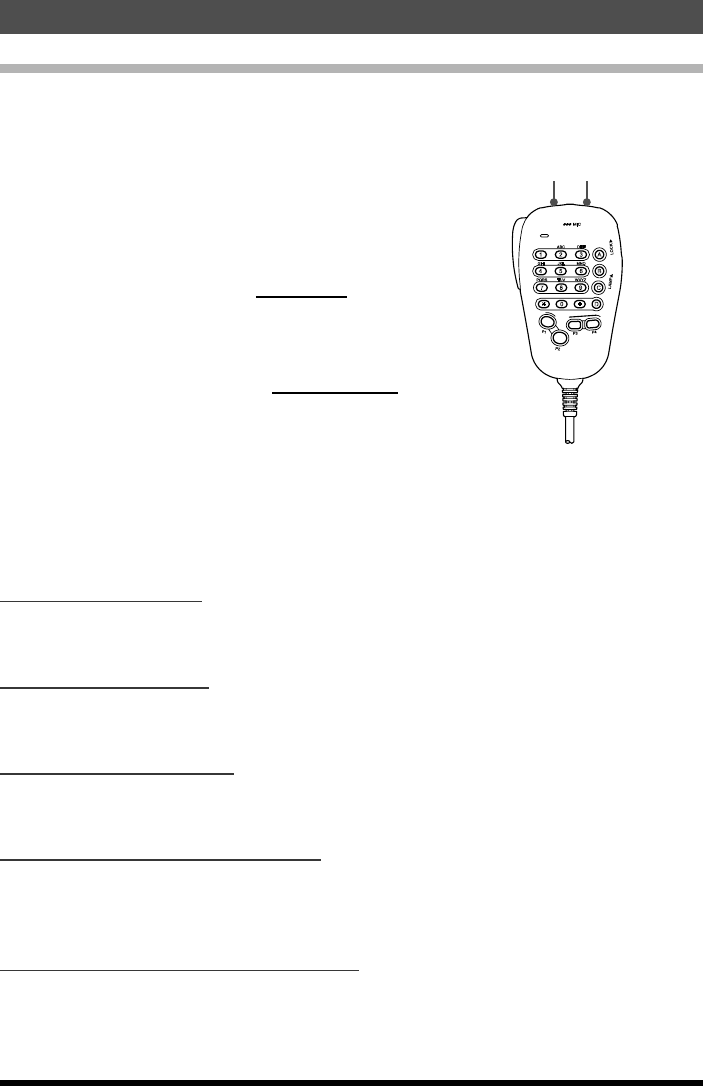
26 FTM-3200DR Operating Manual
Scanning
Basic Scanner Operation
Before activating the scanner, make sure that the Squelch is set to silence the back
ground noise when no signal is present. Scanning is not possible while the Squelch is
open (if noise or signals are being heard).
Scanning may be started or stopped using the micro-
phone’s [UP] or [DWN] button.
The following techniques are used for scanning:
r Pressing and holding in either the [UP] or [DWN]
button for one second in the VFO mode will cause
upward or downward band scanning, respectively,
to begin.
r Pressing and holding in either the [UP] or [DWN]
button for one second in the Memory mode will
cause memory channel scanning toward a higher-
or lower-numbered memory channel, respectively.
LOCK
P3
P2
P1
7
1
4
8
2
0
5
9
B
A
C
D
3
6
P4
LAMP
DTMF MICROPHONE
MH-48
ABC
JKL
TUV
GHI
PQRS
DEF
MNO
WXYZ
MIC
DWN UP
r Scanning pauses when a signal opens the squelch, and the decimal point on the
display will blink. You can choose one of three scan-resume modes (described later).
r
To halt the scan manually, the easiest way is to push the PTT switch on the microphone
momentarily (no transmission will occur while you are scanning). The scan may also be
halted manually by pressing the microphone’s [UP] or [DWN] button, or the [V/M(MW)] key.
Scan Resume Options
Select one of the 3 scan resume modes to be performed after the scanning stops.
Note: For details, refer to the Advanced Manual (download from the Yaesu website).
Memory Skip Scanning
Memory channels which you do not want to receive can be skipped during scanning.
Note: For details, refer to the Advanced Manual (download from the Yaesu website).
Preferential Memory Scan
Set up a “Preferential Scan List” of channels which you can “flag” within the memory system.
Note: For details, refer to the Advanced Manual (download from the Yaesu website).
Programmable Memory Scan (PMS)
Using the dedicated PMS memory channels, only the frequencies within the specified
frequency range will be scanned.
Note: For details, refer to the Advanced Manual (download from the Yaesu website).
Priority Channel Scanning (Dual Watch)
Scanning features include a two-channel scanning capability which allows you to operate
on a VFO, Memory channel, or Home channel, while periodically checking a user defined
Memory Channel for activity.
Note: For details, refer to the Advanced Manual (download from the Yaesu website).
Application for FCC / IC
FCC ID: K6620523X50 / IC: 511B-20523X50
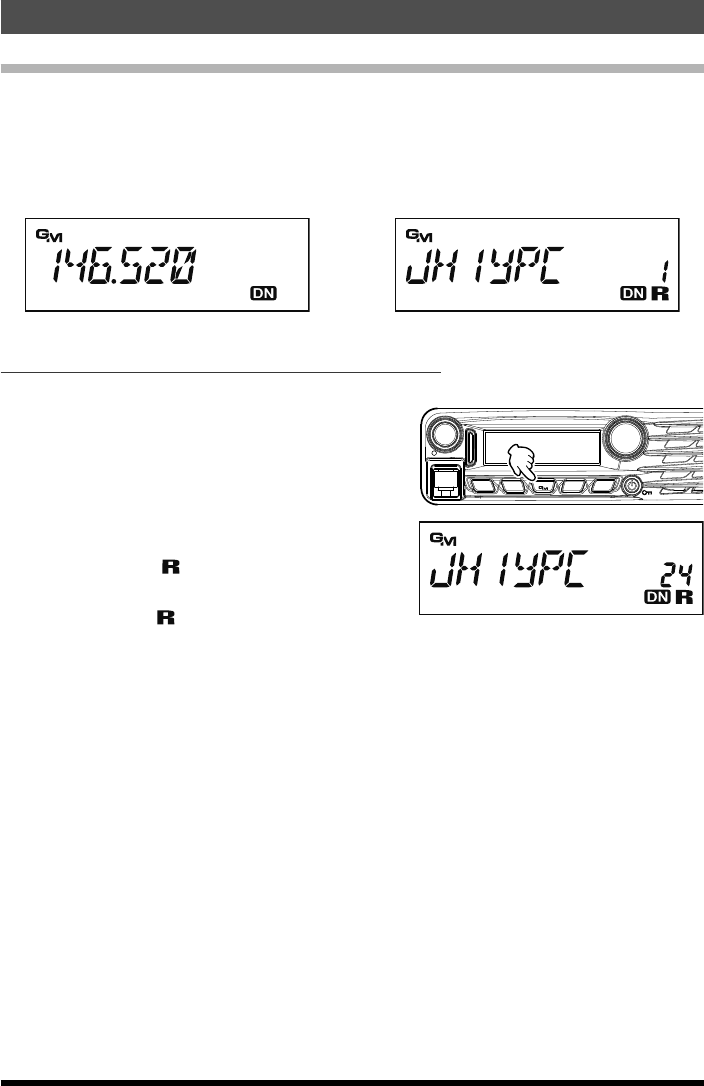
27FTM-3200DR Operating Manual
GM Function
What is the GM (Group Monitor) Function?
The GM function automatically monitors for any other stations with the GM function in
operation on the same frequency, or stations transmitting in DN mode, within communica-
tion range. In addition to notifying you of the group members within your communication
range, the GM function also displays the detected call sign on the transceiver screen.
Caution: The GM function does not work while in the analog (FM) mode.
à
Displaying all the stations using the GM function
1. Tune to the designated frequency.
2. Press and hold in the [D/A(GM)] key for 1
second.
The GM function activates and displays up
to 24 stations using the GM mode on the
same frequency, or stations operating in DN
mode, within the communication range.
Note: Displays “ ”for stations within your
communication range.
Displays “ ” (blinks) for stations out-
side your communication range.
VOL
DIAL
SQL
TXPO DW MW
SETUP
REV D/A V/MMHz
3. Press and hold in the [D/A(GM)] key for 1 second to disable the GM function and return
to the frequency screen.
Application for FCC / IC
FCC ID: K6620523X50 / IC: 511B-20523X50
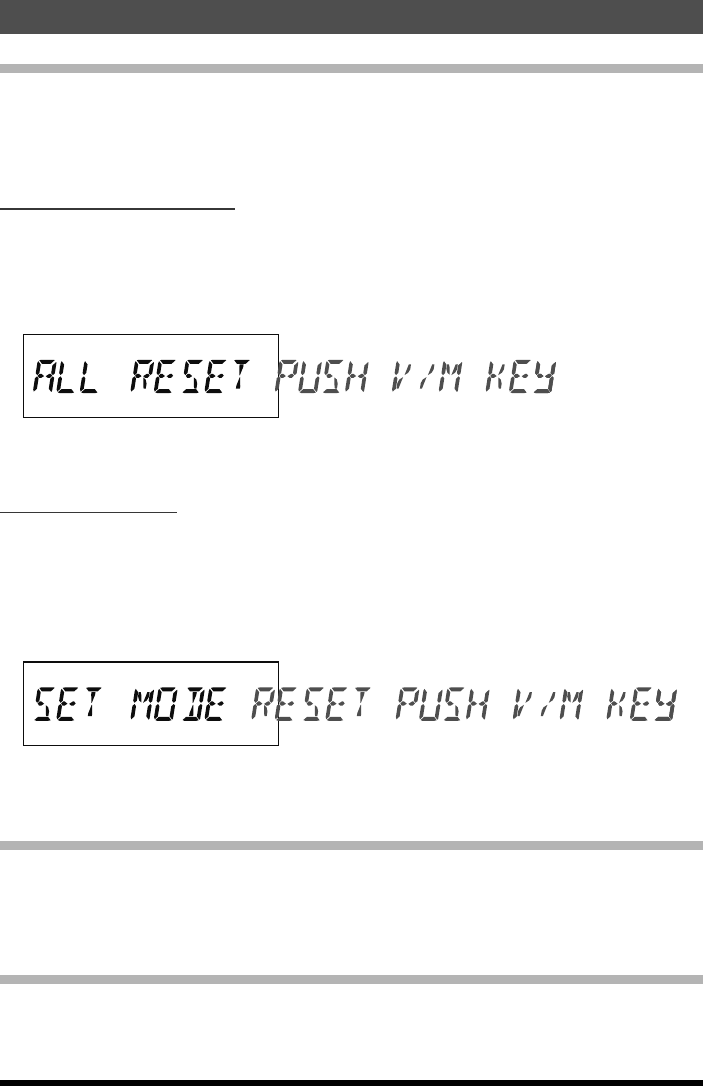
28 FTM-3200DR Operating Manual
Miscellaneous Settings
Reset Procedure
In some instances of erratic or unpredictable operation, the cause may be corruption of
data in the microprocessor (due to static electricity, etc.). If this happens, resetting of the
micro processor may restore normal operation. Note that all memories will be erased if
you do a complete microprocessor reset, as described below.
Microprocessor Resetting
To clear all memories and other settings to factory defaults:
1. Turn the radio off.
2. Press and hold in the [D/A(GM)], [MHz(SETUP)], and [V/M(MW)] keys while turning
the radio on. The “ALL RESET PUSH V/M KEY” notation will scroll on the display.
3. Press the [D/MR(MW)] key momentarily to reset all settings to their factory defaults(-
press any other key to cancel the Reset procedure).
Set Mode Resetting
To reset the Set (Menu) mode settings to their factory defaults, while leaving other settings
unchanged:
1. Turn the radio off.
2. Press and hold in the [D/A(GM)] and [MHz(SETUP)] keys while turning the radio on.
The “SET MODE RESET PUSH V/M KEY” notation will scroll on the display.
3. Press the [D/MR(MW)] key momentarily to reset the Set (Menu) mode settings to their
factory defaults (press any other key to cancel the Reset procedure).
Programming the Key Assignments
Default FTM-3200DR key functions have been assigned to the Microphone’s [P1]/[P2]/
[P3]/[P4] keys at the factory. These may be changed by the user, if you wish to assign
quick access to another function.
Note: For details, refer to the Advanced Manual (download from the Yaesu website).
Keyboard Beeper
A key/button beeper provides useful audible feedback whenever a key/button is pressed.
If you want to turn the beeper off (or back on again).
Note: See Setup Menu Item “BEP KEY 3” on page xx.
Application for FCC / IC
FCC ID: K6620523X50 / IC: 511B-20523X50
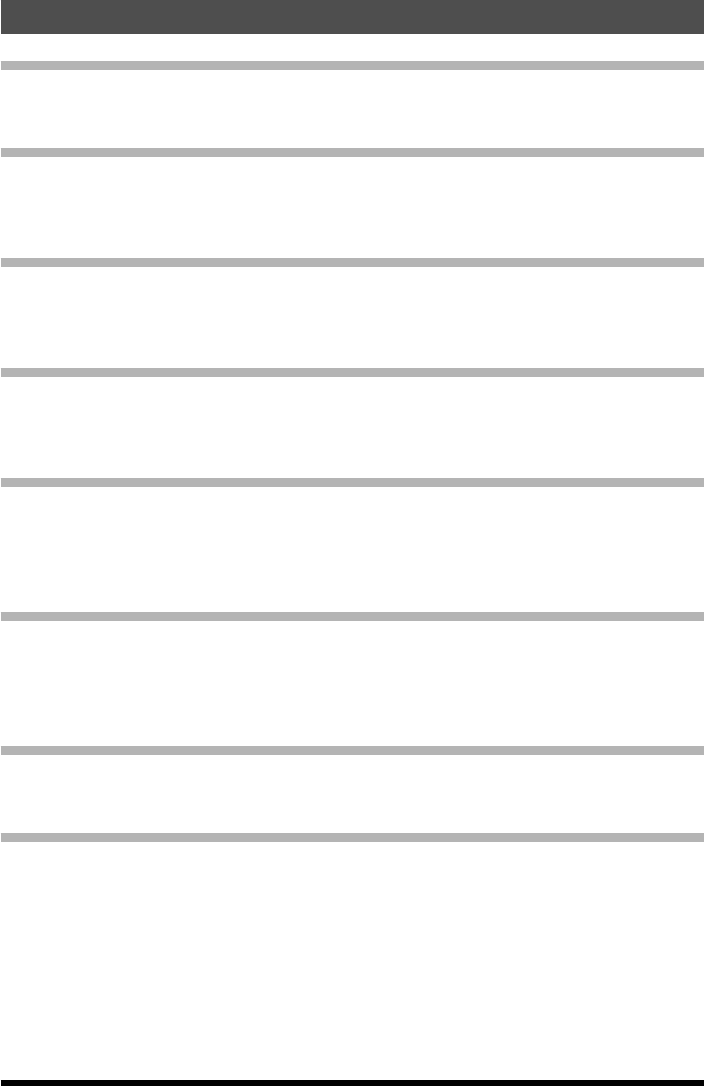
29
Miscellaneous Settings
FTM-3200DR Operating Manual
Display Brightness
You can adjust the display brightness.
Note: See Setup Menu Item “LCD DMMR 22” on page xx.
Time-Out-Timer (TOT)
The “Time-Out Timer” (TOT) feature is designed to force the transceiver into the “receive”-
mode after a preset time period of continuous transmission (the default is 3 minutes).
Note: See Setup Menu Item “TOT 46” on page xx.
Automatic Power Off (APO)
The “Automatic Power-Off” (APO) feature will turn the radio completely off after a user
defined period of PTT or key/button inactivity.
Note: See Setup Menu Item “APO 1” on page xx.
Busy Channel Lock-Out (BCLO)
The BCLO feature prevents the radio’s transmitter from being activated if a signal strong
enough to break through the “noise” squelch is present.
Note: See Setup Menu Item “BCLO 2” on page xx.
TX Deviation Level
You can reduce the receiver bandwidth and microphone deviation level when operating
on tightly-clustered frequencies (channel spacing of 12.5 or 15 kHz). This will reduce the
transmitter deviation, thus minimizing interference to other users.
Note: See Setup Menu Item “W/N DEV 52” on page xx.
MIC Gain Setting
At the factory, a microphone gain has been programmed that should be satisfactory for
the supplied MH-48A6J Microphone. If you use an after-market microphone or connect a
TNC, you may wish to set a different Mic Gain level.
Note: See Setup Menu Item “MIC GAIN 24” on page xx.
Displaying the Supply Voltage
Display the Power Supply voltage.
Note: See Setup Menu Item “DC VOLT 8” on page xx.
Displaying the Temperature
Indicates indicate the current temperature inside the transceiver’s case.
Note: See Setup Menu Item “TEMP 44” on page xx.
Application for FCC / IC
FCC ID: K6620523X50 / IC: 511B-20523X50

30 FTM-3200DR Operating Manual
Packet Operation
The FTM-3200R may be used for 1200 bps Packet operation, using most all commonly
available Terminal Node Controllers (TNCs). Connections between the transceiver and
the TNC are accomplished via the front panel Microphone connector and rear panel
External Speaker jack, per the diagram below.
The audio level from the receiver to the TNC may be adjusted by using the VOL knob, as
with voice operation. The input level to the FTM-3200R from the TNC may be adjusted via
Setup Menu Item “MIC GAIN 24” see page xx for details.
Be sure to turn the transceiver and TNC off before connecting the cables, so as to prevent
voltage spikes from possibly damaging your transceiver.
Remember to readjust the default microphone input level to “LEVEL 5” (Setup Menu Item
“MIC GAIN 24”) when Packet operation is finished.
Application for FCC / IC
FCC ID: K6620523X50 / IC: 511B-20523X50

31FTM-3200DR Operating Manual
Cloning
The FTM-3200R includes a convenient “Clone” feature, which allows the memory and
configuration data from one transceiver to be transferred to another FTM-3200R.
This can be particularly useful when configuring a number of transceivers for a public
service operation.
Here is the procedure for Cloning one radio’s data to another:
1. Turn both radios off.
2. Connect the user-constructed cloning cable between the MIC jacks of the two radios.
3. Press and hold in the [LOW(A/N)] key while turning the radios on. Do this for both ra-
dios (the order of switch-on does not matter). “CLONE” will appear on the displays of
both radios when the Clone mode is successfully activated in this step.
4. On the Destination radio, press the [D/MR(MW)] key (“- -WAIT- -” will appear on the
LCD).
5. Press the [MHz(SET)] key on the Source radio; “- - - -TX- - - -” will appear on the
Source radio, and the data from this radio will be transferred to the other radio.
6. If there is a problem during the cloning process, “ERROR” will be displayed. Check
your cable connections and battery voltage, and try again.
7. If the data transfer is successful, “CLONE” will appear on both displays.
8. Press any key to exit to normal operation.
9. Turn both radios off and disconnect the cloning cable.
Application for FCC / IC
FCC ID: K6620523X50 / IC: 511B-20523X50
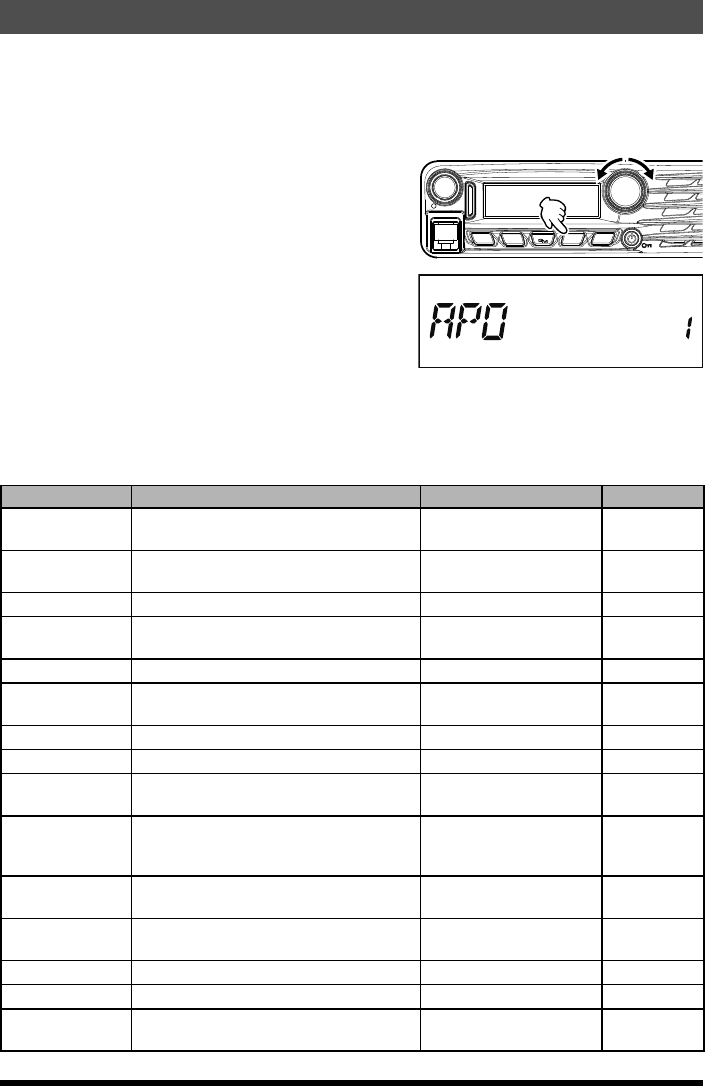
32 FTM-3200DR Operating Manual
Setup (Menu) Mode
The FTM-3200R Setup (Menu) mode, already described in parts of many previous
chapters, is easy to activate and set. It may be used for configuration of a wide variety
of transceiver parameters, some of which have not been detailed previously. Use the
following procedure to activate the Setup (Menu) mode:
1. Press and hold in the [MHz(SETUP)] key for
1 second to enter the Setup menu.
2. Rotate the DIAL knob to select the Menu
Item to be adjusted.
3. Press the [MHz(SETUP)] key momentarily
to enable adjustment of the selected Menu
item, then rotate the DIAL knob to perform
the actual adjustment.
4. After completing your selection and adjust-
ment, press and hold in the [MHz(SETUP)]
key for 1 second to exit the Setup menu and
resume normal operation.
VOL
DIAL
SQL
TXPO DW MW
SETUP
REV D/A V/MMHz
Menu Item Function Available Values Default
1: APO Enables/Disables the Automatic Power
Off feature.
0.5H to 12H (0.5H step)/
OFF OFF
2: BCLO Enables/Disables the Busy Channel
Lock-Out feature. ON/OFF OFF
3: BEP KEY Enables/Disables the key beeper. KEY+SCAN/KEY/OFF KEY+SCAN
4: BEP EDGE Enables/Disable the Band-edge beeper
while scanning. ON/OFF OFF
5: BEP STBY Enables/Disable the Standby beep ON/OFF ON
6: BELL Selects the CTCSS/DCS/EPCS Bell
Ringer repetitions. 1 to 20/CONTINUE/OFF OFF
7: CLK TYPE Shifting of the CPU clock frequency. A/B A
8: DC VOLT Indicates the DC Supply Voltage. --- ---
9: DCS CODE Setting of the DCS code. 104 standard DCS
codes 023
10: DCS INV
Select a combination of DCS inversion
codes in terms of communication direc-
tion.
NORMAL/INVERT/
BOTH NORMAL
11: DIG AMS Sets the transmission mode TXMANUAL/TX FMFIX/
TX DNFIX/AUTO TXMANUAL
12: DI POPUP Sets the information pop-up time 2/4/6/8/10/20/30/60/
CONTINUE/OFF 10 SEC
13: DSQ CODE Sets the squelch code in digital mode. 001 to 126 CODE 001
14: DSQ TYPE Sets the squelch type in digital mode. OFF/CODE/BREAK OFF
15: DT AUTO Enables/Disables the DTMF Autodialer
feature. MANUAL/AUTO MANUAL
Application for FCC / IC
FCC ID: K6620523X50 / IC: 511B-20523X50

33
Setup (Menu) Mode
FTM-3200DR Operating Manual
Menu Item Function Available Values Default
16: DT DELAY Setting of the DTMF Autodialer’s TX De-
lay Time. 50/250/450/750/1000 450 MS
17: DT SET Loading of the DTMF Autodialer Memo-
ries. --- ---
18: DT SPEED Setting of the DTMF Autodialer Sending
Speed. 50/100 50 MS
19: DW RVRT Enables/Disables the “Priority Channel
Revert” feature. ON/OFF OFF
20: GM RINGR
Enables/Disables the alert sound when
detecting stations within communication
range
IN RANGE
/
ALWAYS
/OFF IN RANGE
21: GM INTVL Selects the automatic sending interval. NORMAL/LONG NORMAL
22: LCD DMMR Setting of the front panel display’s illumi-
nation level. LEVEL 1/2/3/4 LEVEL 4
23: LOCK Selects the Control Locking Lockout
combination.
KEY+DIAL/PTT/
KEY+PTT/DIAL+PTT/
ALL/KEY/DIAL
KEY+DIAL
24: MIC GAIN Adjust the microphone gain level. LEVEL 5 to 9 LEVEL 5
25: MEM NAME Programming an Alpha/Numeric label for
a Memory Channel. --- ---
26: MW MODE Selects the method of selection of chan-
nels for Memory Storage. NEXT CH/LOWER CH NEXT CH
27: OPEN MSG Selects the Opening Message that ap-
pears when the radio is powered ON. OFF/DC/MESSAGE MESSAGE
28: PAG CD-R
Setting the Receiver Pager Code for
the Enhanced CTCSS Paging & Code
Squelch function.
--- 05 47
29: PAG CD-T
Setting the Transmitting Pager Code for
the Enhanced CTCSS Paging & Code
Squelch function.
--- 05 47
30: PAG P1 Programming the function assigned to
Microphone’s [P1] key.
SQL OFF
HOME
WX CH
CD SRCH
SCAN
T CALL
TX POWER
DIG/ANA
GM
Setup Menu Item #1 to
53
SQL OFF
31: PAG P2 Programming the function assigned to
Microphone’s [P2] key. HOME
32: PAG P3 Programming the function assigned to
Microphone’s [P3] key. CD SRCH
33: PAG P4 Programming the function assigned to
Microphone’s [P4] key.
Depends on
the transceiv-
er version.
34: RADIO ID Displays the transceiver IDs øøø (uneditable) ---
35: RF SQL Adjusts the RF Squelch threshold level. ON/OFF OFF
36: RPT ARS Activates/Deactivates the Automatic Re-
peater Shift feature. ON/OFF ON
37: RPT FREQ Sets the magnitude of the Repeater Shift. 0.00 - 99.95 (MHz) 0.60 MHz
38: RPT SFT Sets the Repeater Shift direction. -RPT/+RPT/SIMP SIMP
39: SCAN RSM Selects the Scan Resume mode.
BUSY
/
HOLD
/2-10 (SEC) 5.0 SEC
Application for FCC / IC
FCC ID: K6620523X50 / IC: 511B-20523X50

34
Setup (Menu) Mode
FTM-3200DR Operating Manual
Menu Item Function Available Values Default
40: SCAN SKP Selects the Memory Scan mode. OFF/SKIP/SELECT OFF
41: SQL EXP Sets the squelch type separately for
transmission and reception. ON/OFF OFF
42: SQL TYPE Selects the Tone Encoder and/or Decod-
er mode.
TONE/TSQ/DCS/RV
TONE/PAG/OFF OFF
43: STEP Sets the Synthesizer steps. AUTO/5/6.25/10/12.5/15
/20/25/50/100 (Hz) AUTO
44: TEMP Indicats the current temperature inside
the transceiver’s case. F/C USA: F
EXP: C
45: TONE FRQ Setting of the CTCSS Tone Frequency. 67.0 to 254.1 (Hz) 100.0 HZ
46: TOT Sets the Time-Out Timer. 0.5 to 10.0 (MIN) 3.0 MIN or
OFF
47: TS MUTE
Enables/Disables the receiver audio out-
put during the Tone Search Scanner is
activated.
ON/OFF ON
48: TS SPEED Selects the Tone Search Scanner speed. FAST/SLOW FAST
49: VER DISP Displays the transceiver software version CPU x.xx
DSP x.xx ---
50: WX ALERT Enables/Disables the Weather Alert fea-
ture. ON/OFF OFF
51: WX VOL Selects the audio output level of the
Weather Alert. NOR.VOL/MAX.VOL NOR VOL
52: W/N DEV Reduction of the Microphone Gain/Devia-
tion and receiver bandwidth. WIDE/NARROW WIDE
53: MY CALL Sets your station call sign øøøøøøøøøø ---
Application for FCC / IC
FCC ID: K6620523X50 / IC: 511B-20523X50

35FTM-3200DR Operating Manual
Specifications
General
Frequency Range: Tx 144 - 148 MHz
Rx 136 - 174 MHz
Channel Step: 5/6.25/10/12.5/15/20/25/50/100 kHz
Standard Repeater Shift: ±600 kHz
Frequency Stability: ±2.5 ppm [-4 °F to +140 °F (-20 °C to +60 °C)]
Modes of Emission: F3E/F7W
Antenna Impedance: 50 Ohms, unbalanced
Supply voltage: 13.8 V DC ±15 %, negative ground
Current Consumption (typical): Rx: less than 0.7 A, less than 0.5 A (squelched)
Tx: 15 A (65 W) /10 A (30 W) /5 A (5 W)
Operating Temperature Range: -4° F to +140° F (-20° C to +60° C)
Case Size (WxHxD): 6.1” x 1.7” x 6.1” (154 x 43 x 155 mm) (w/o knobs)
Weight (Approx.): 2.86 lb (1.3 kg)
Transmitter
Output Power: 65/30/5 W
Modulation Type: F3E: Variable Reactance
F7W: 4FSK (C4FM)
Maximum Deviation: ±5 kHz (Wide)
±2.5 kHz (Narrow)
Spurious Radiation: Better than -60 dB
Microphone Impedance: 2 k Ohms
Receiver
Circuit Type: Double Conversion Superheterodyne
Ifs: 1st 47.25 MHz, 2nd 450 kHz
Sensitivity (for 12dB SINAD): 0.20 μV (Ham band, wide)
0.22 μV (Ham band, narrow)
Sensitivity (for Digital): 0.22 μV (BER 1 %)
Selectivity (–6/–60dB): 12 kHz/28 kHz
Maximum AF Output: 3 W @ 13.8 V, 10 % THD (EXP SP)
Rated values are at normal temperature and pressure.
Ratings and specifications are subject to change without notice.
Application for FCC / IC
FCC ID: K6620523X50 / IC: 511B-20523X50

36
Specifications
FTM-3200DR Operating Manual
1. Changes or modifications to this device not expressly approved by YAESU MUSEN could void the
user’s authorization to operate this device.
2. This device complies with part 15 of the FCC Rules. Operation is subject to the following two
conditions: (1) This device may not cause harmful interference, and (2) this device must accept any
interference including received, interference that may cause undesired operation.
3. The scanning receiver in this equipment is incapable of tuning, or readily being altered, by the User
to operate within the frequency bands allocated to the Domestic public Cellular Telecommunications
Service in Part 22.
This device complies with Industry Canada license-exempt RSS standard(s). Operation is subject
to the following two conditions: (1) this device may not cause interference, and (2) this device must
accept any interference, including interference that may cause undesired operation of the device.
Le présent appareil est conforme aux CNR d’Industrie Canada applicables aux appareils radio
exempts de licence. L’exploitation est autorisée aux deux conditions suivantes : (1) l’appareil ne doit
pas produire de brouillage, et (2) l’utilisateur de l’appareil doit accepter tout brouillage radioélectrique
subi, même si le brouillage est susceptible d’en compromettre le fonctionnement.
DECLARATION BY MANUFACTURER
The Scanner receiver is not a digital scanner and is incapable of being converted or modified to a
digital scanner receiver by any user.
WARNING: MODIFICATION OF THIS DEVICE TO RECEIVE CELLULAR RADIOTELEPHONE
SERVICE SIGNALS IS PROHIBITED UNDER FCC RULES AND FEDERAL LAW.
CAN ICES-3 (B) / NMB-3 (B)
Application for FCC / IC
FCC ID: K6620523X50 / IC: 511B-20523X50

Copyright 2016
YAESU MUSEN CO., LTD.
All rights reserved.
No portion of this manual
may be reproduced
without the permission of
YAESU MUSEN CO., LTD.
Printed in Japan
1601A-0O
*EH052N100*
EH052N100
YAESU MUSEN CO., LTD.
Tennozu Parkside Building
2-5-8 Higashi-Shinagawa, Shinagawa-ku, Tokyo 140-0002 Japan
YAESU USA
6125 Phyllis Drive, Cypress, CA 90630, U.S.A.
YAESU UK
Unit 12, Sun Valley Business Park, Winnall Close
Winchester, Hampshire, SO23 0LB, U.K.
Application for FCC / IC
FCC ID: K6620523X50 / IC: 511B-20523X50